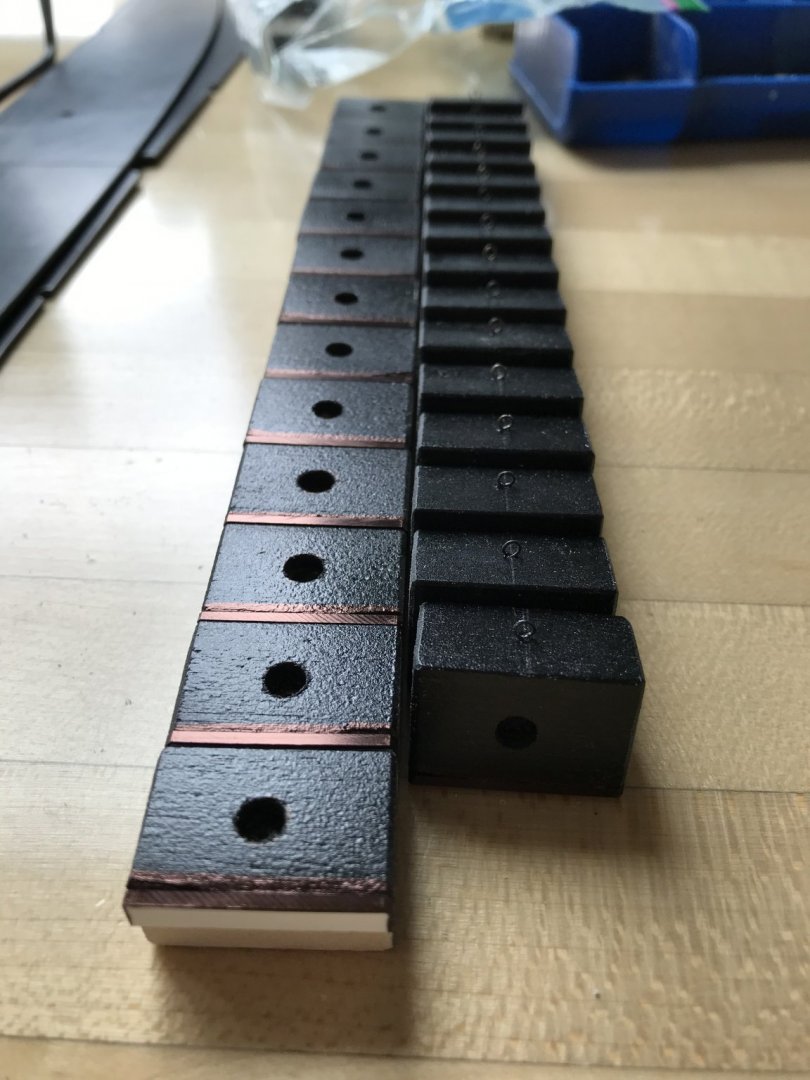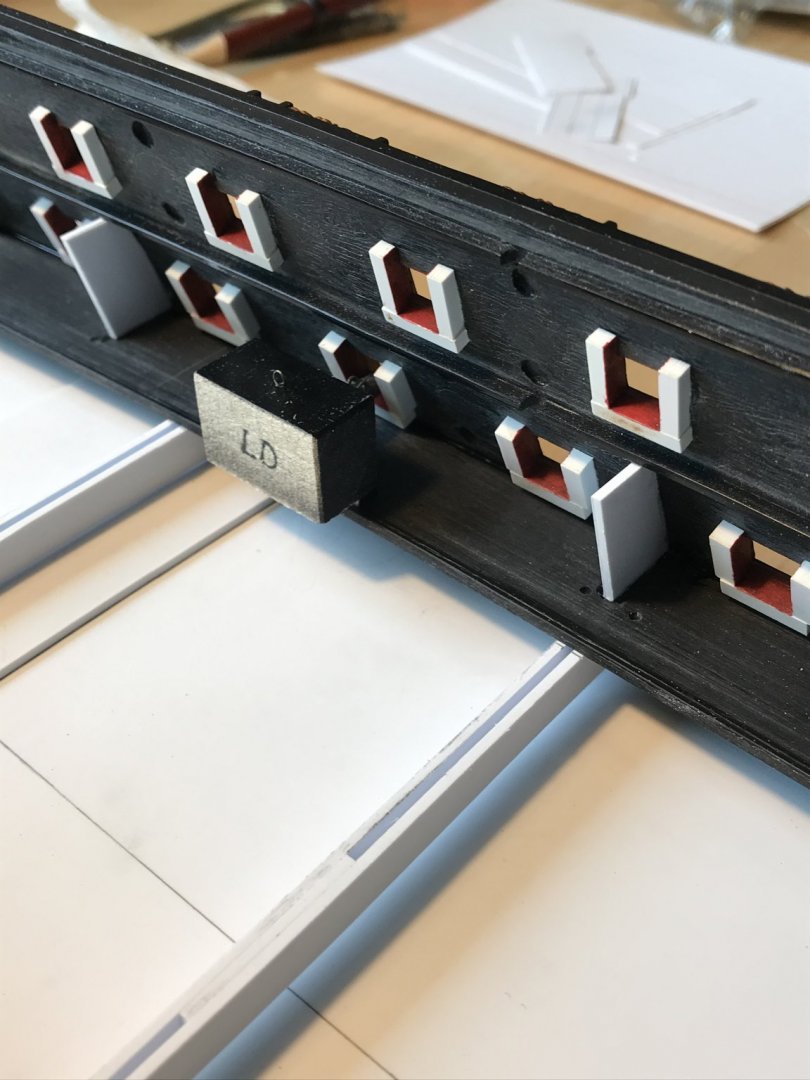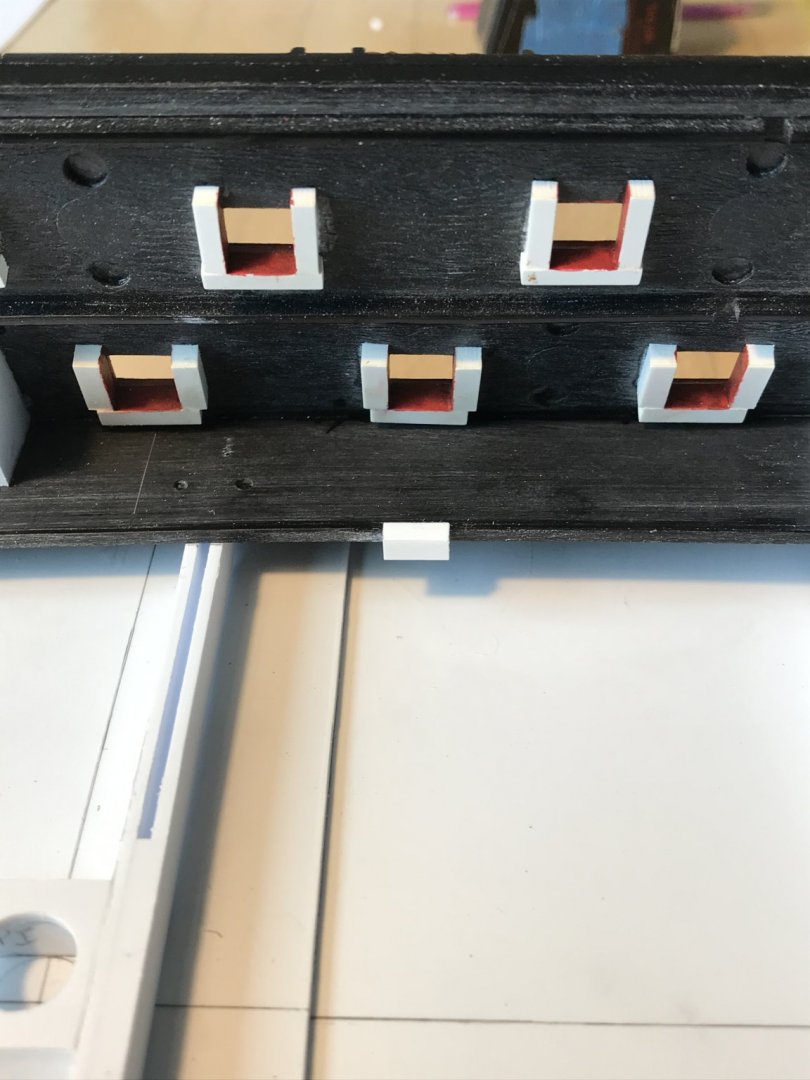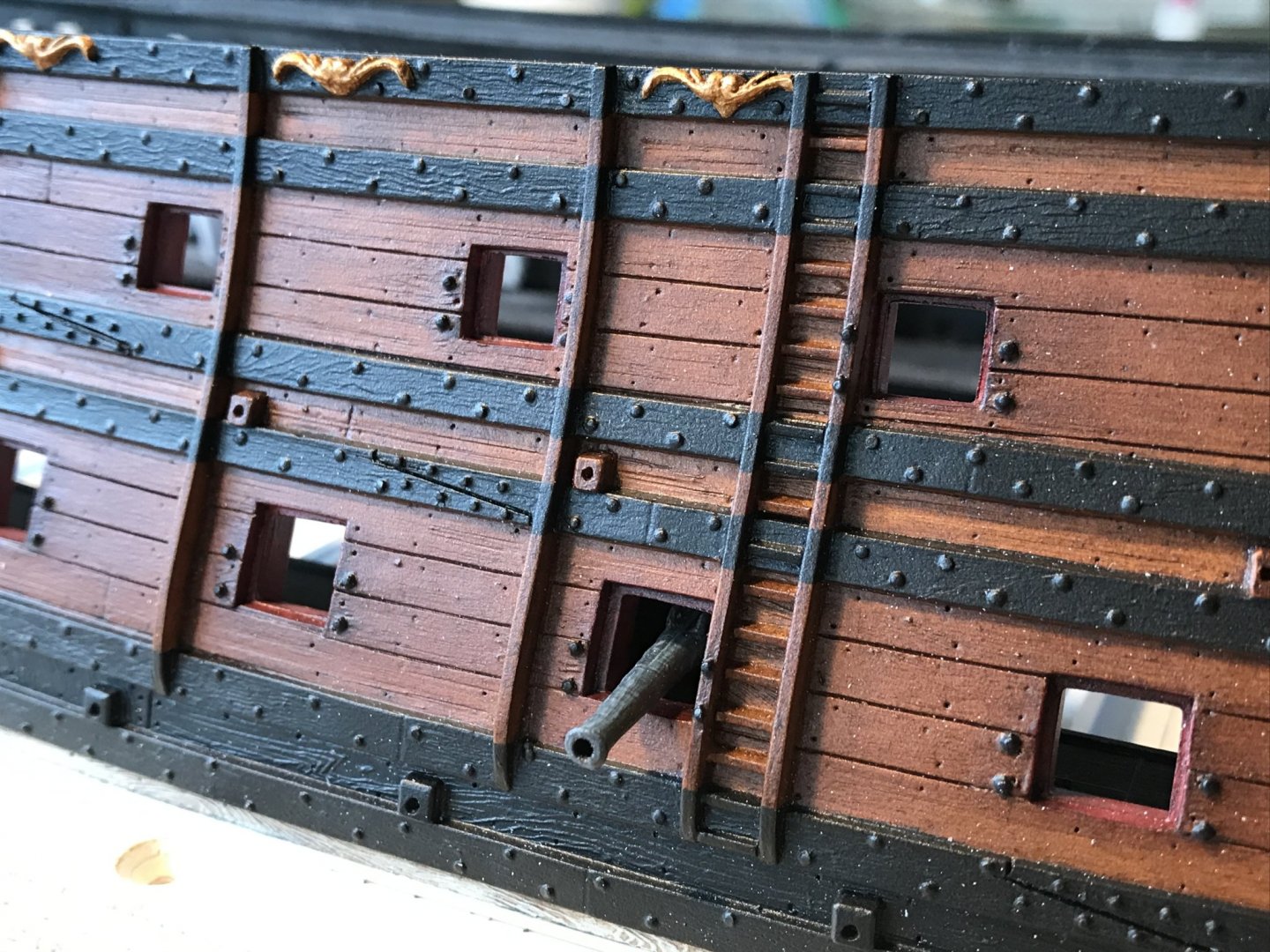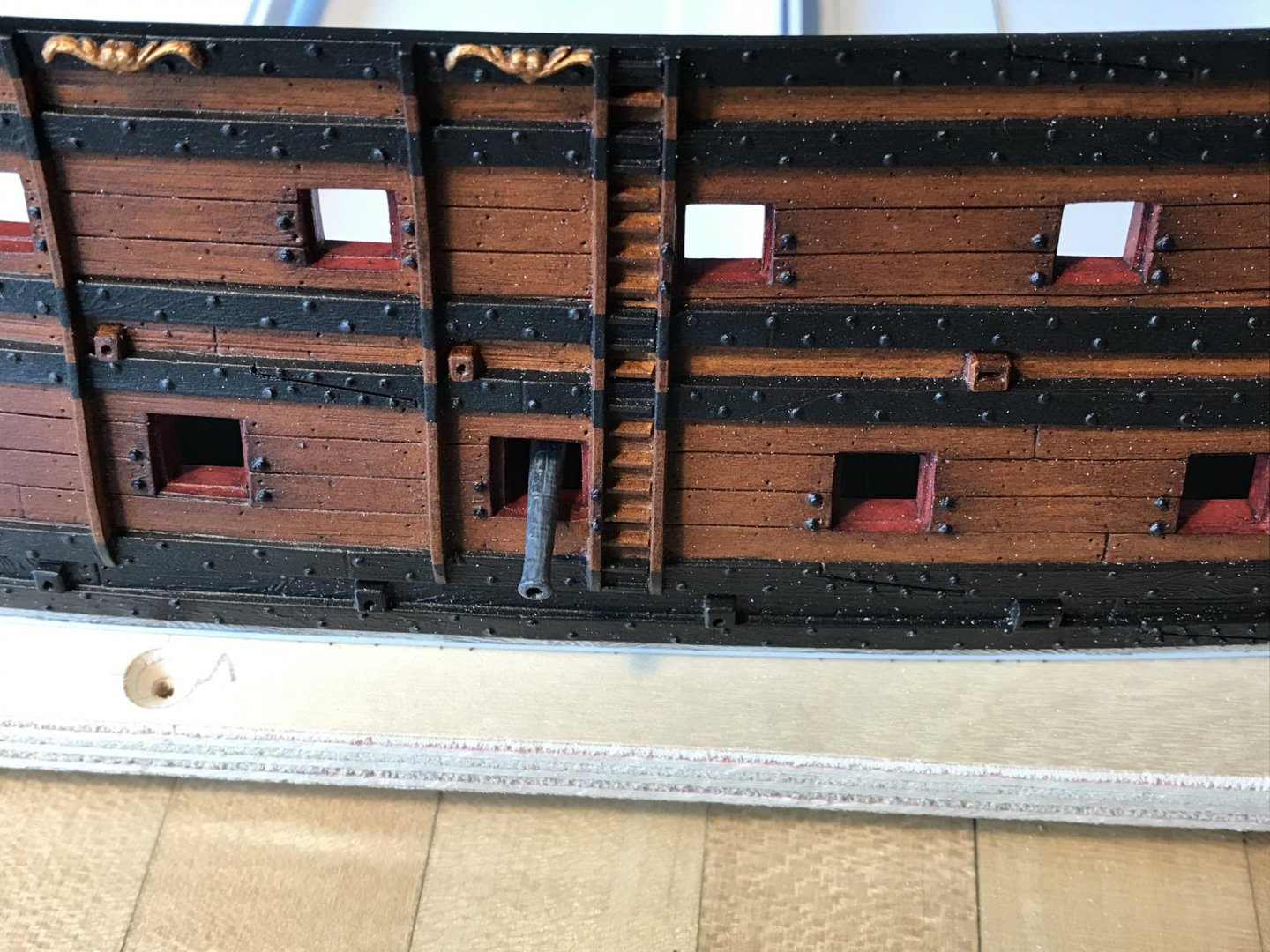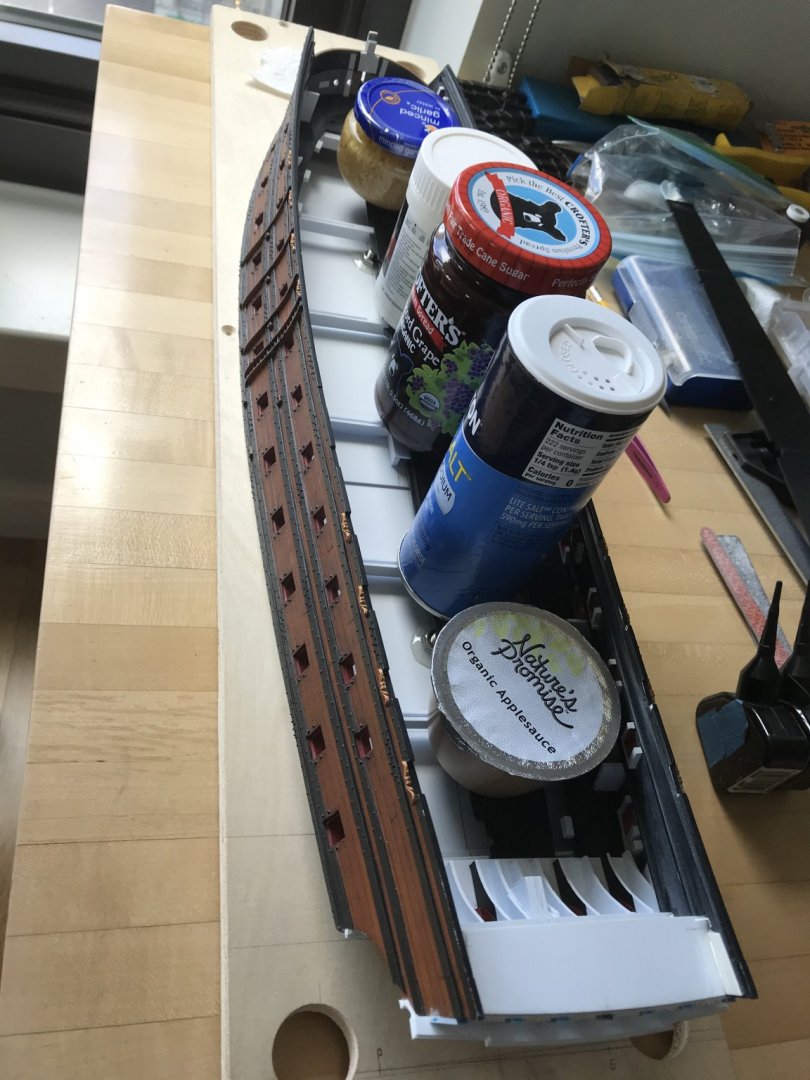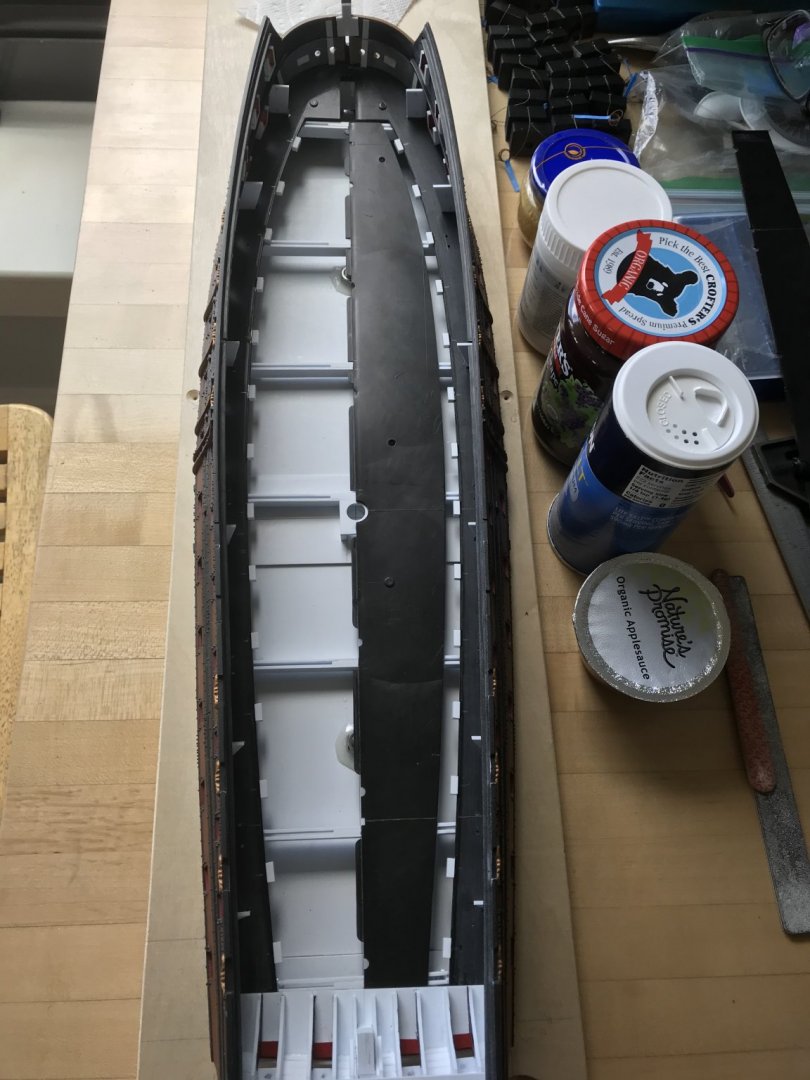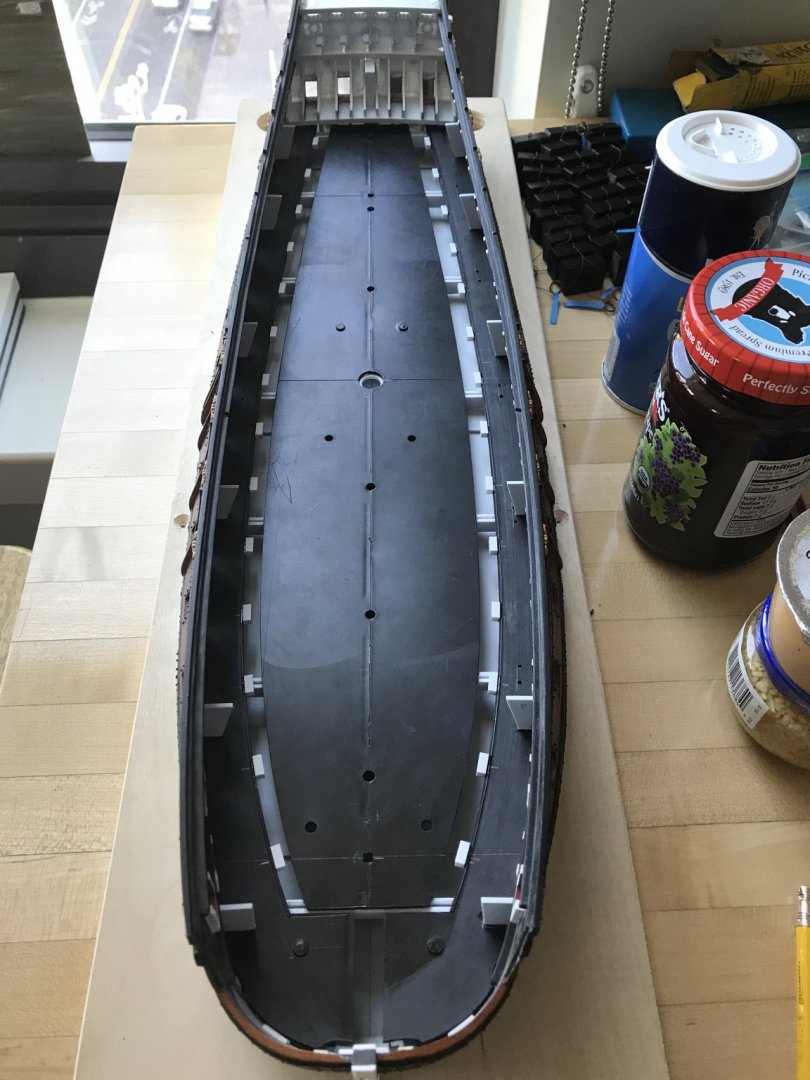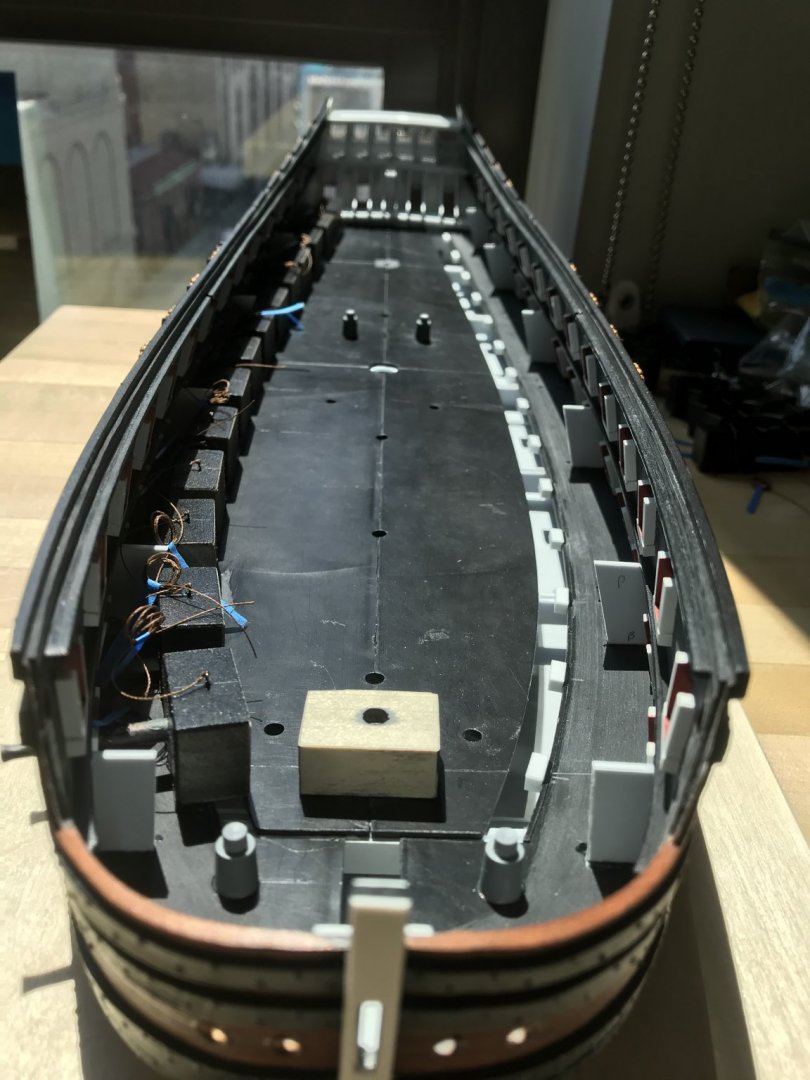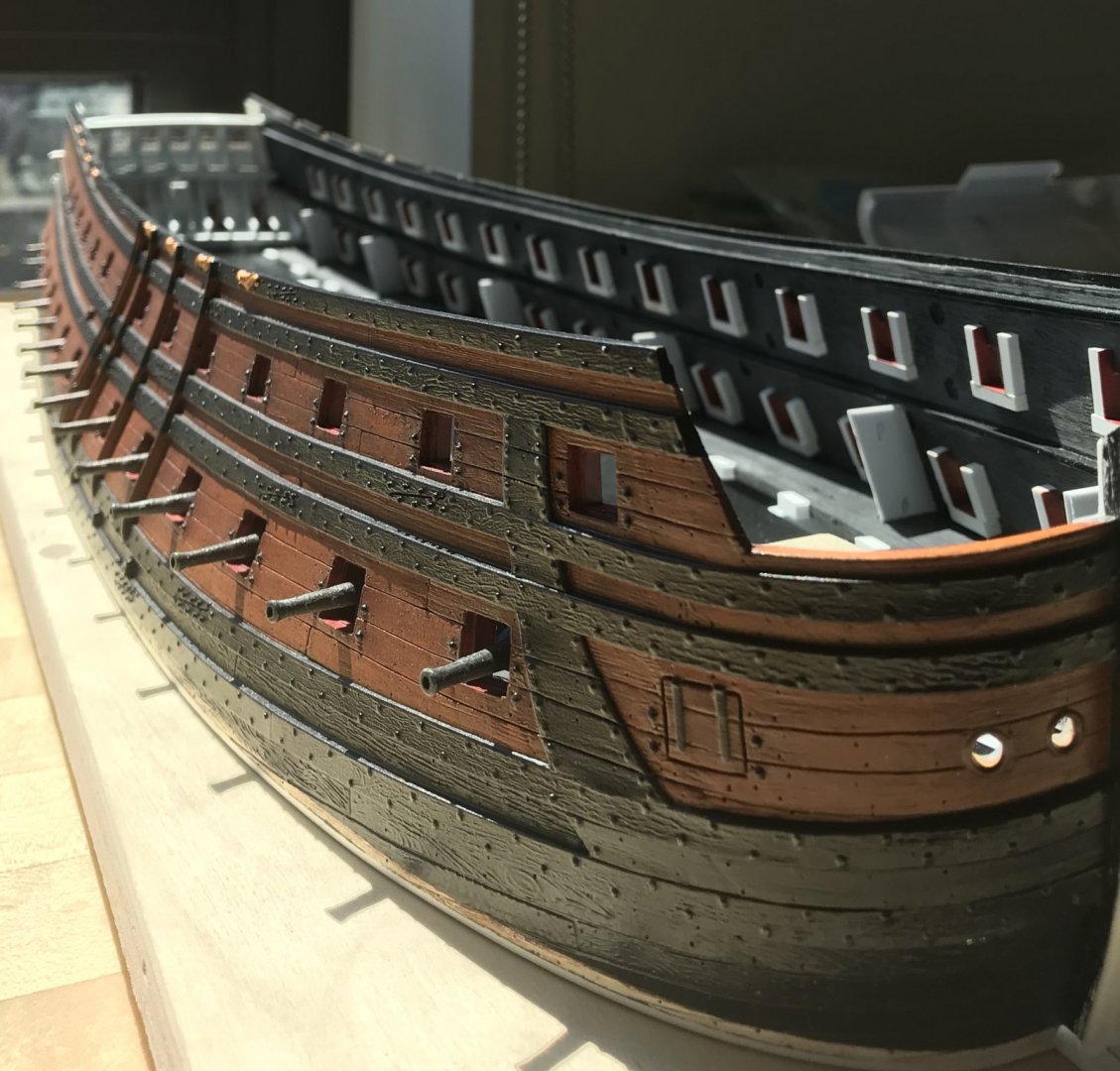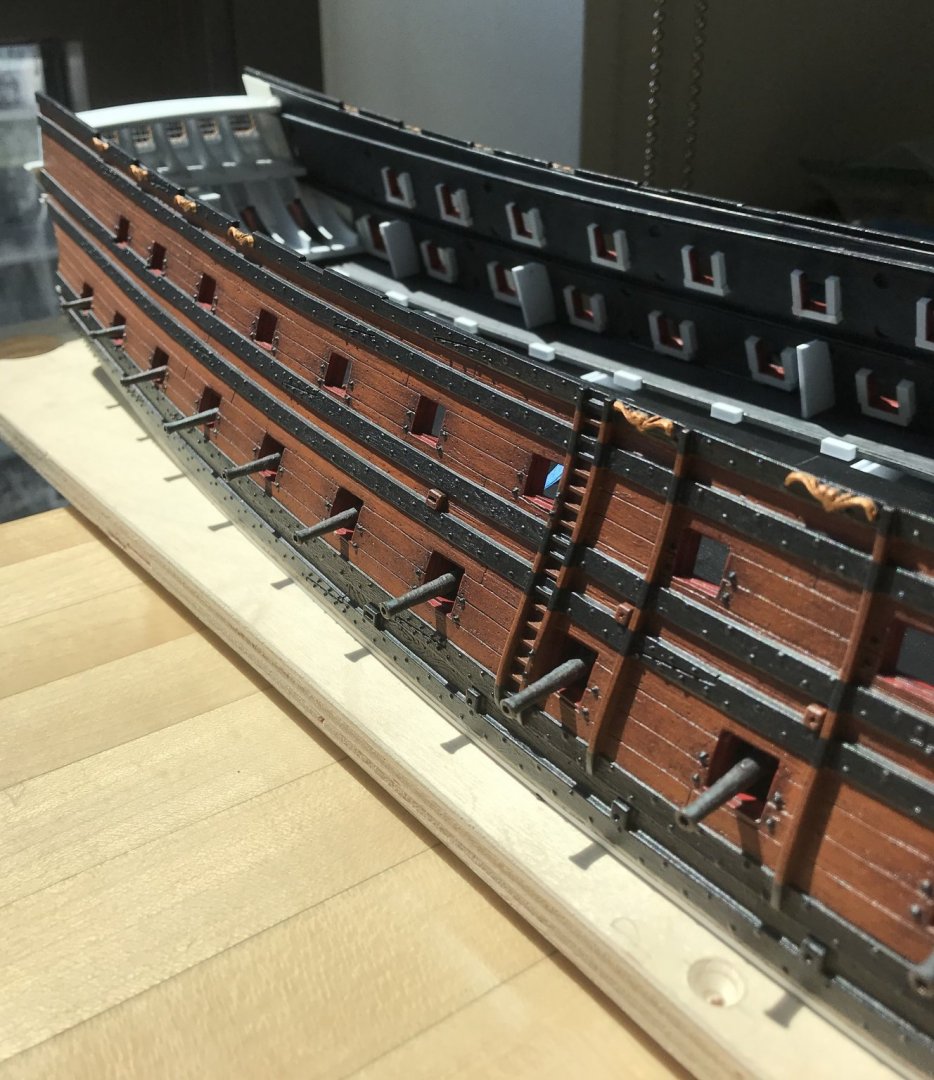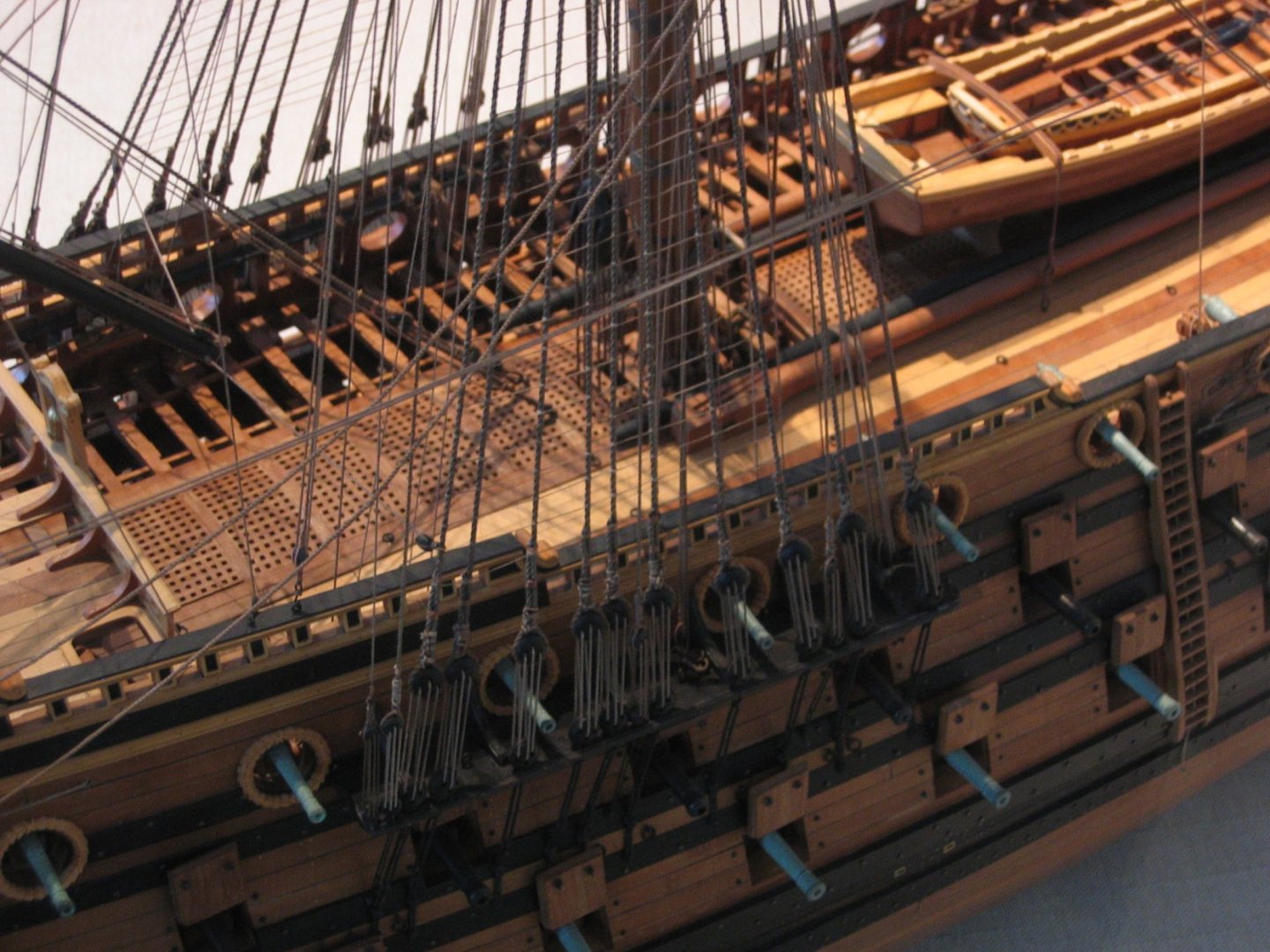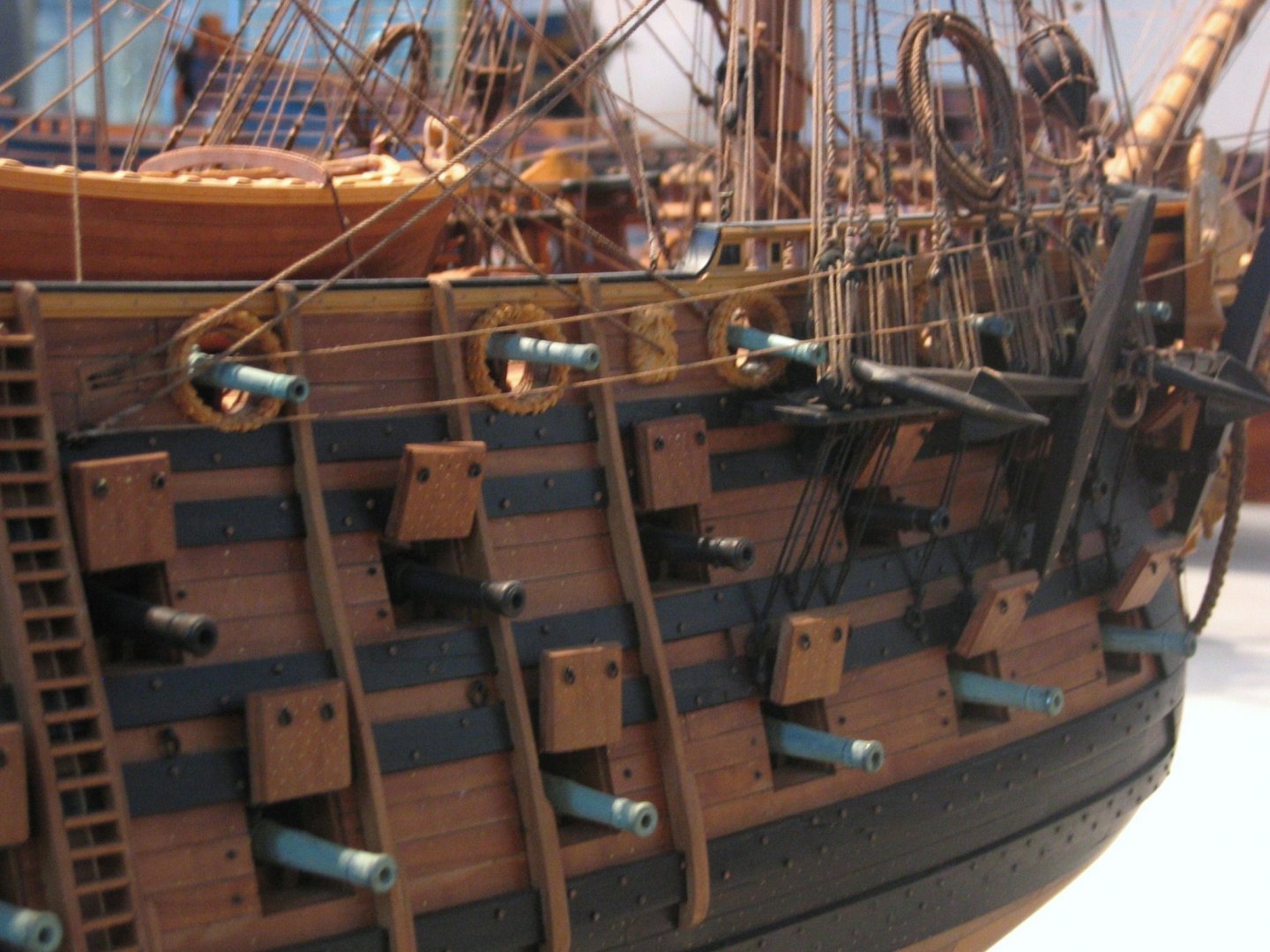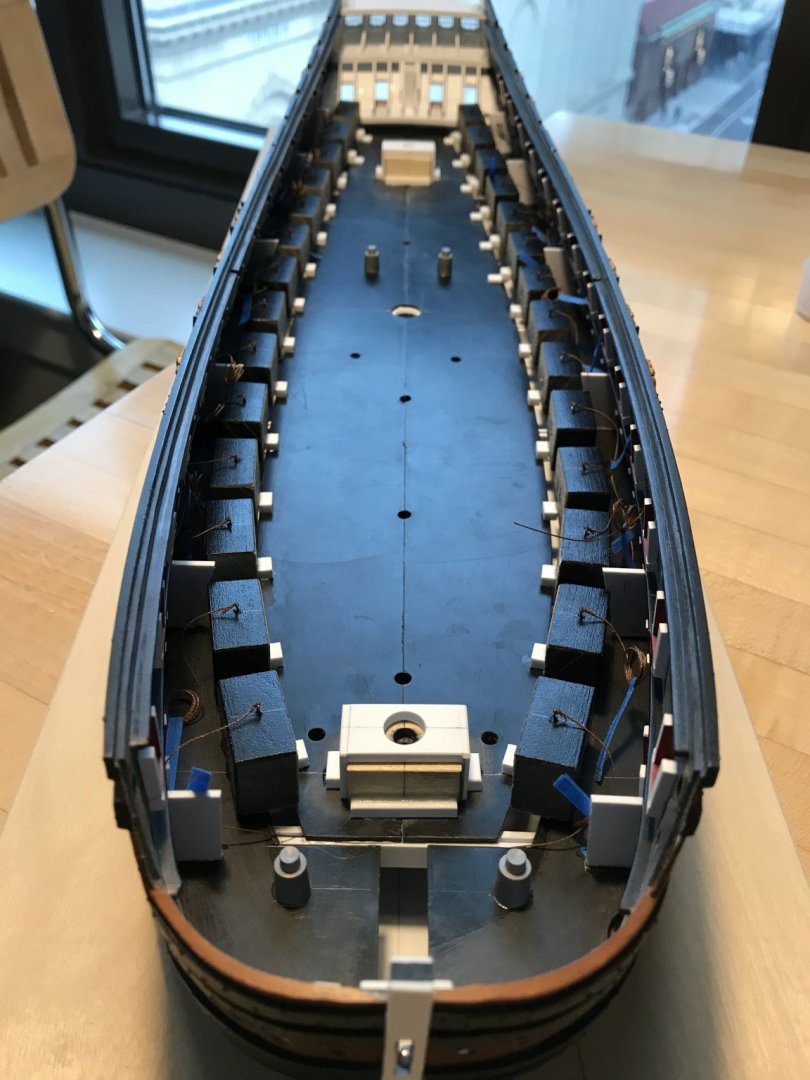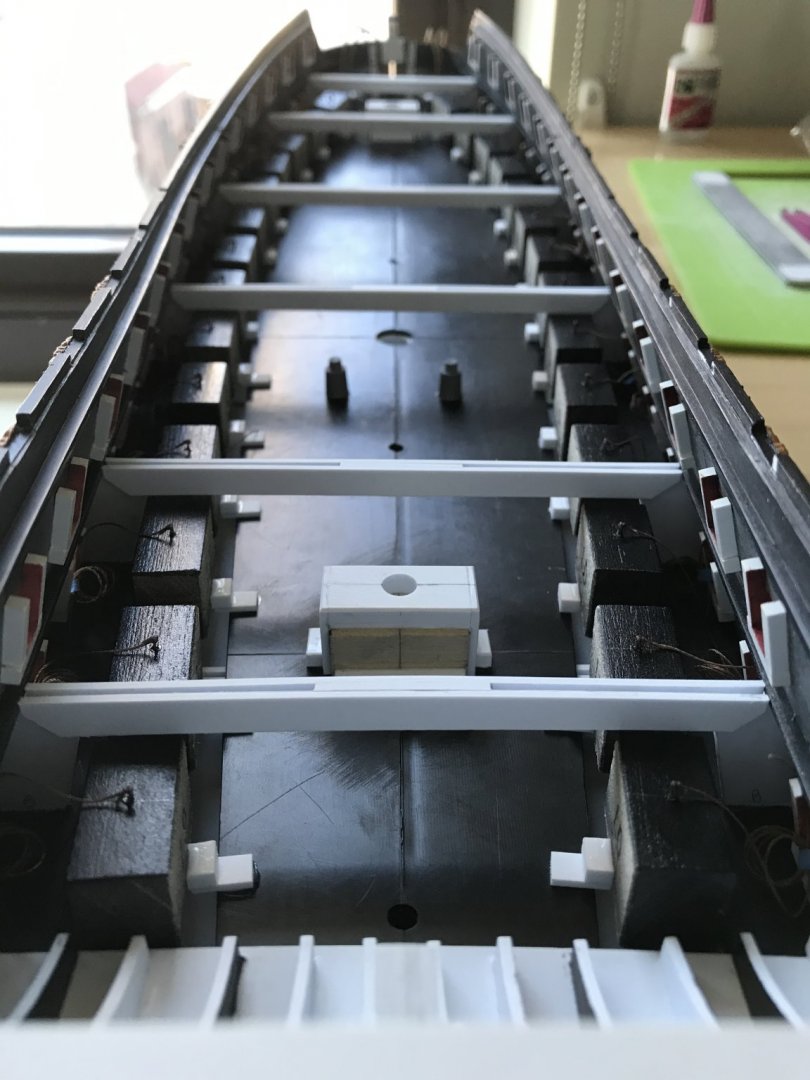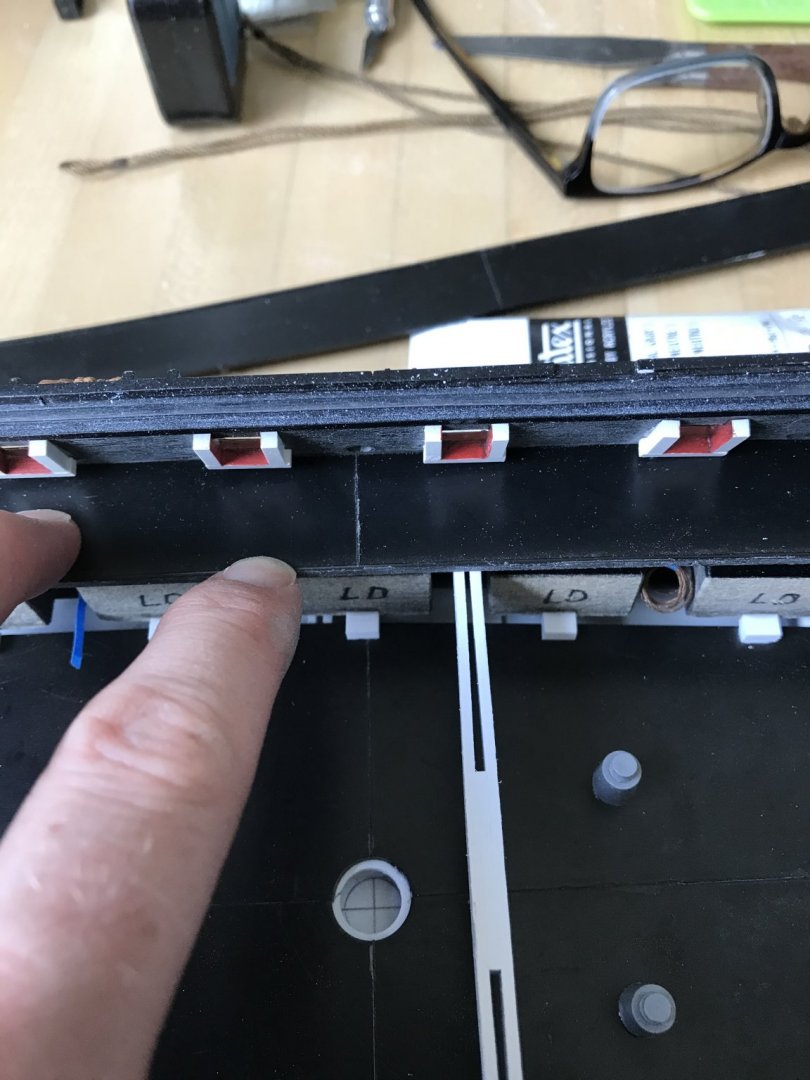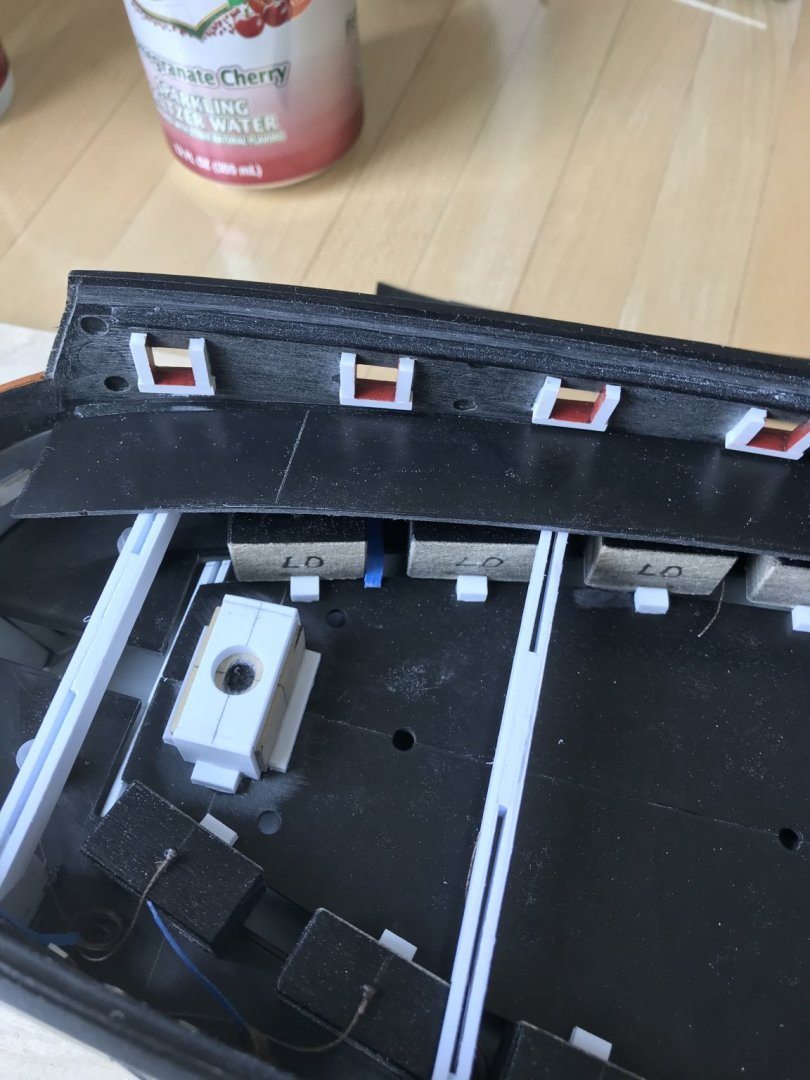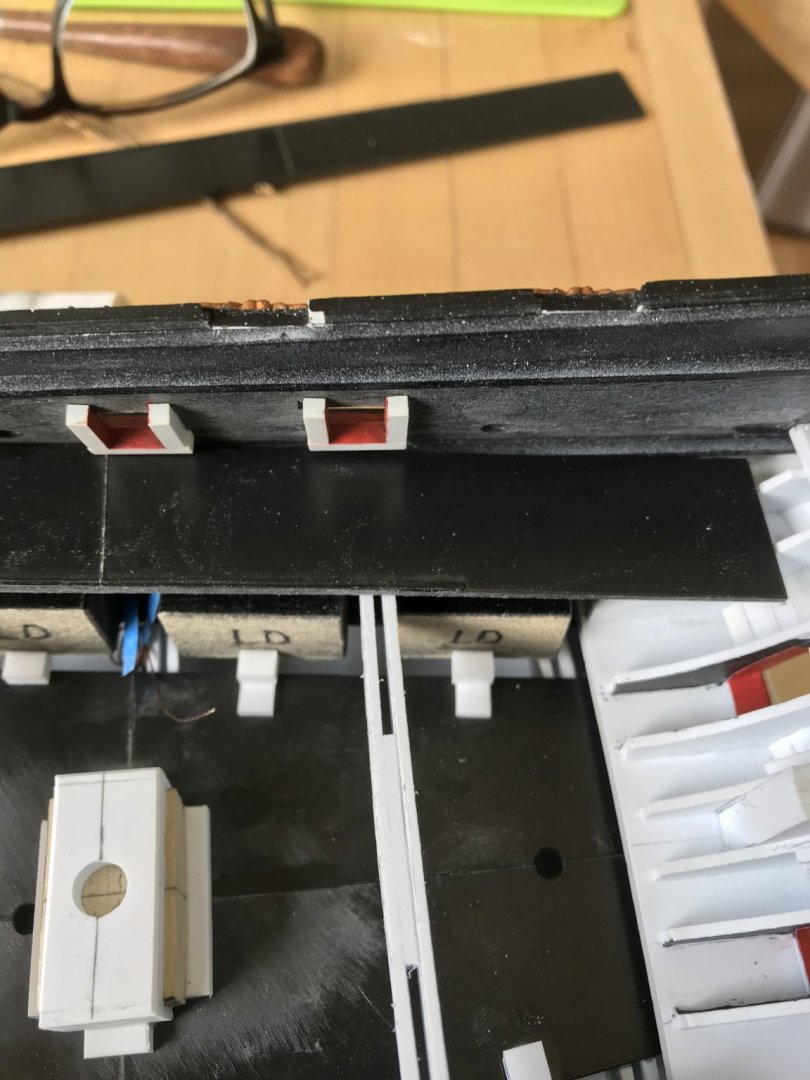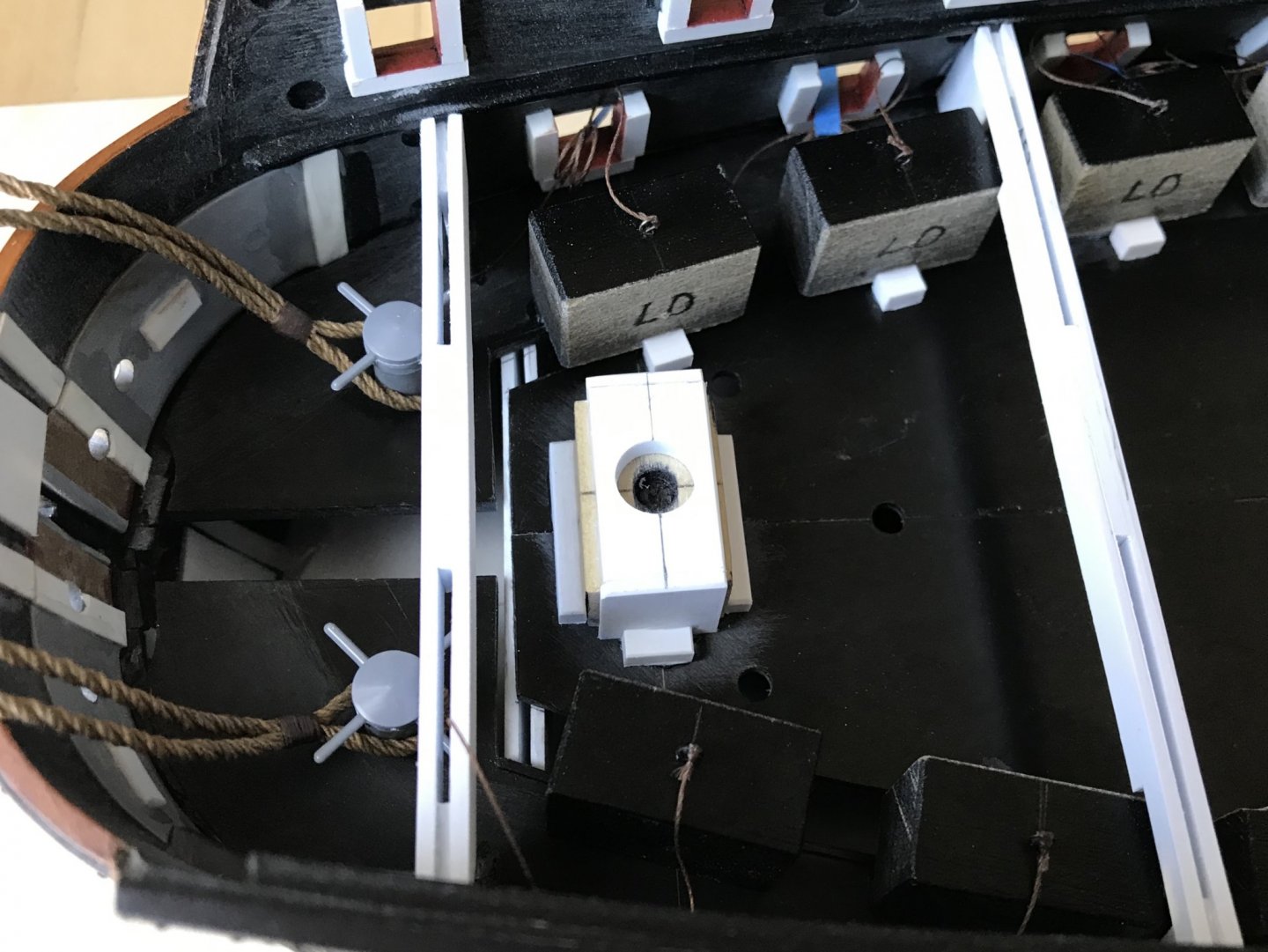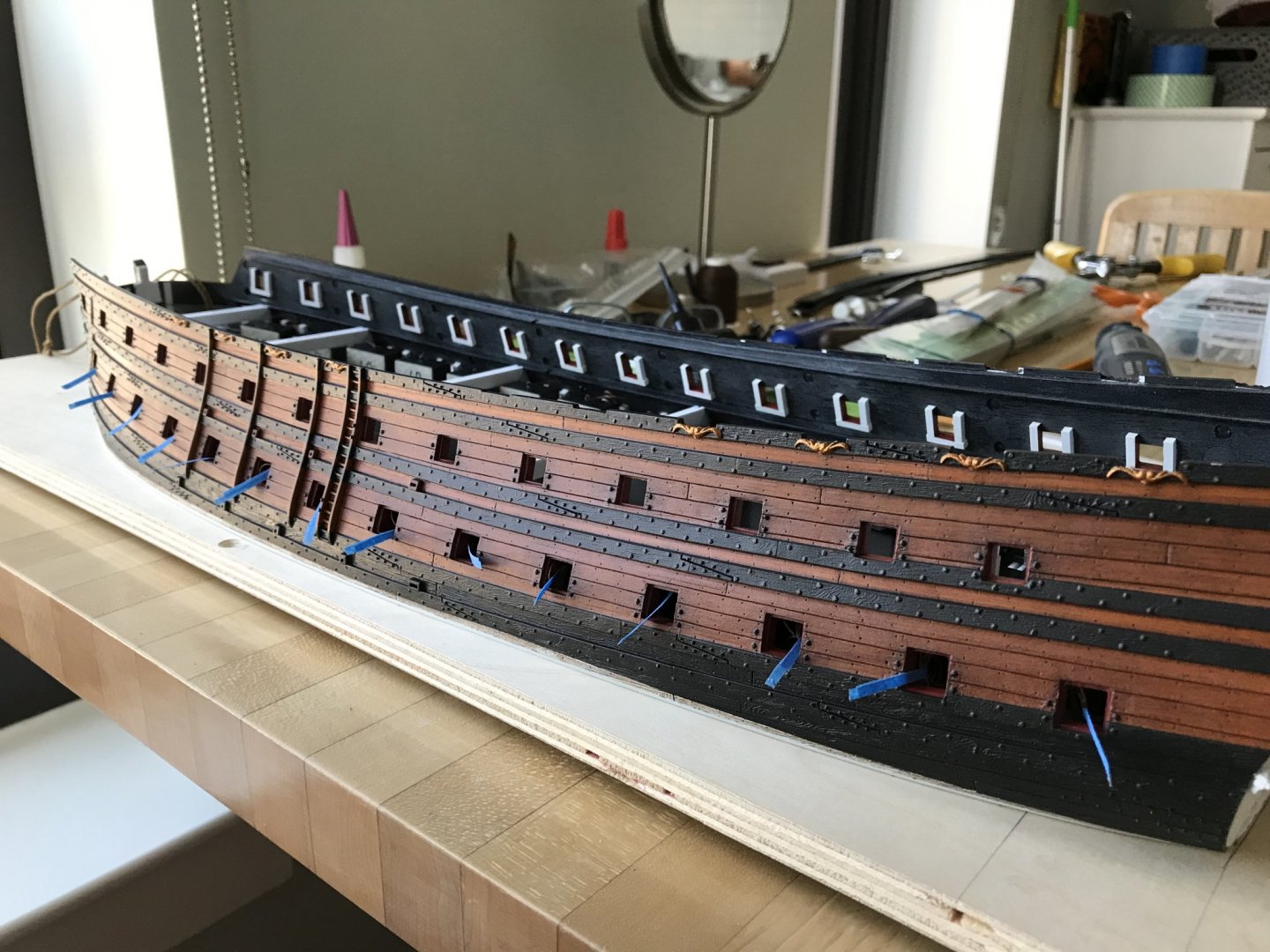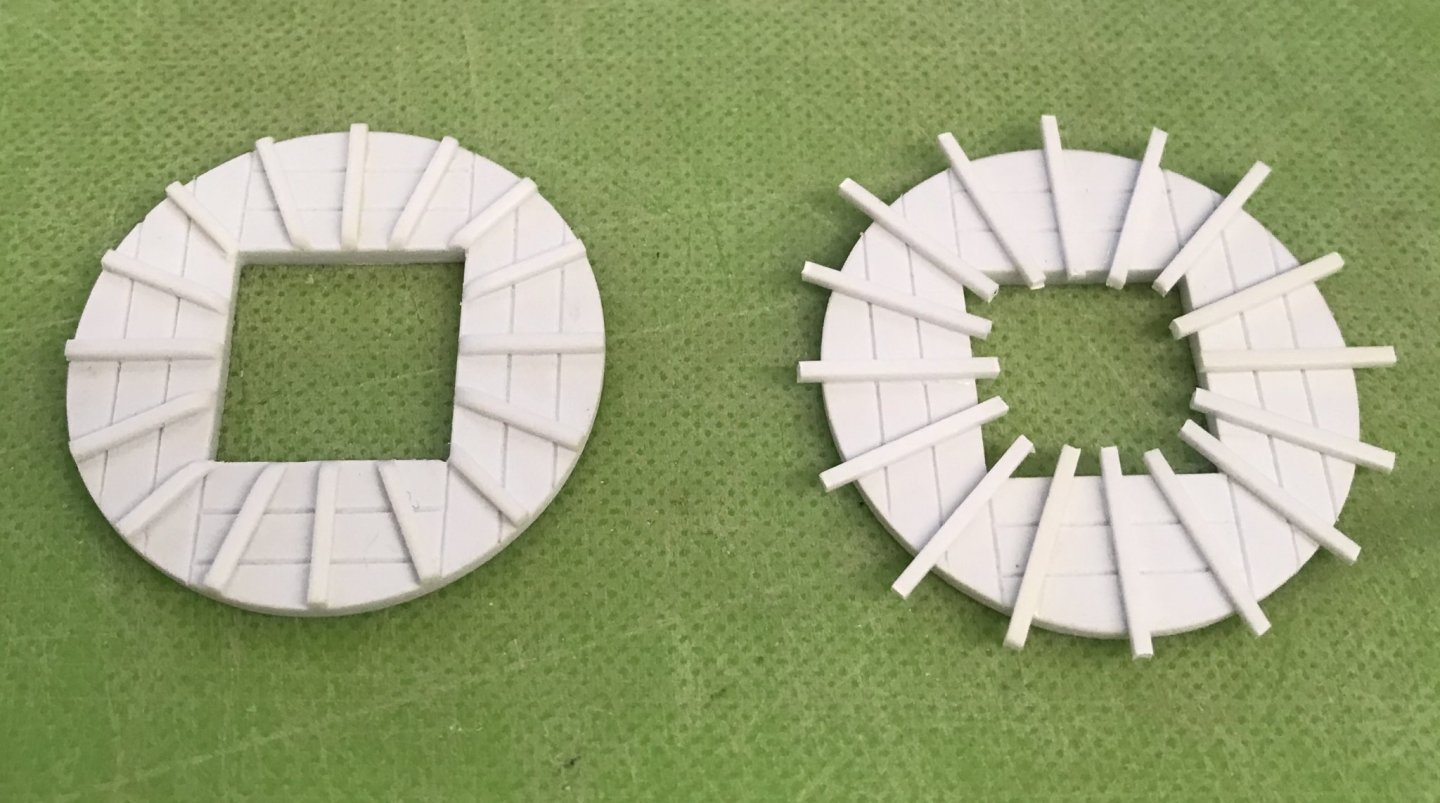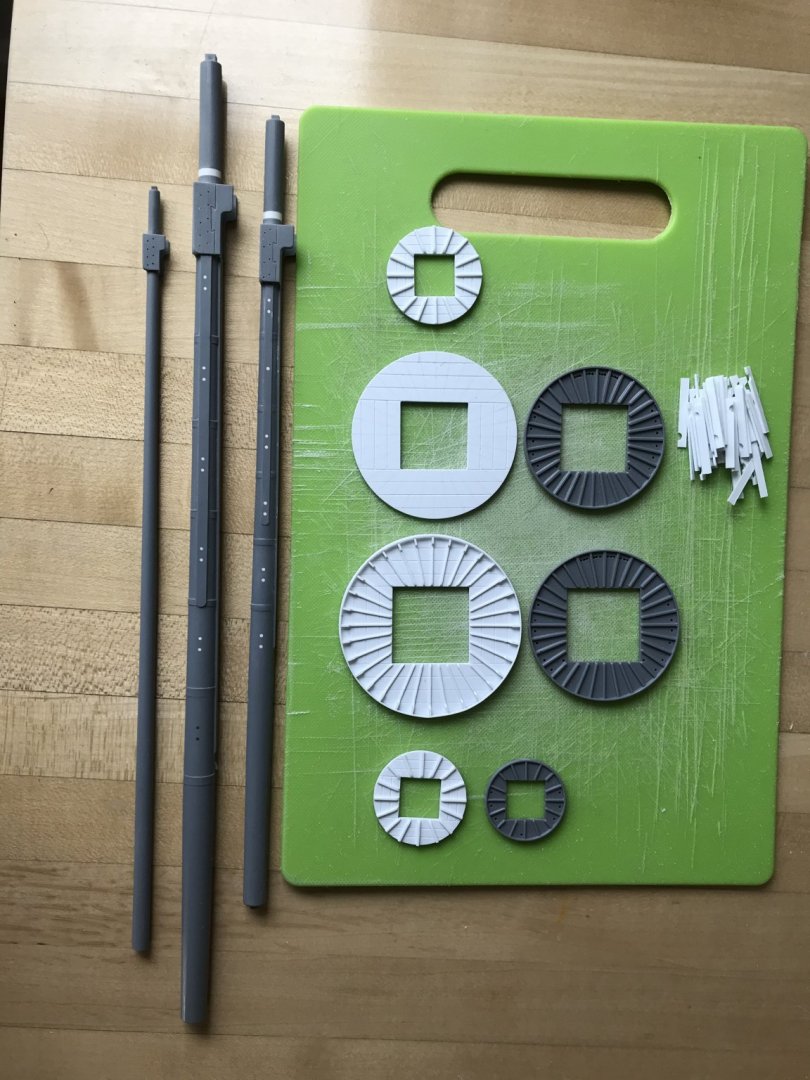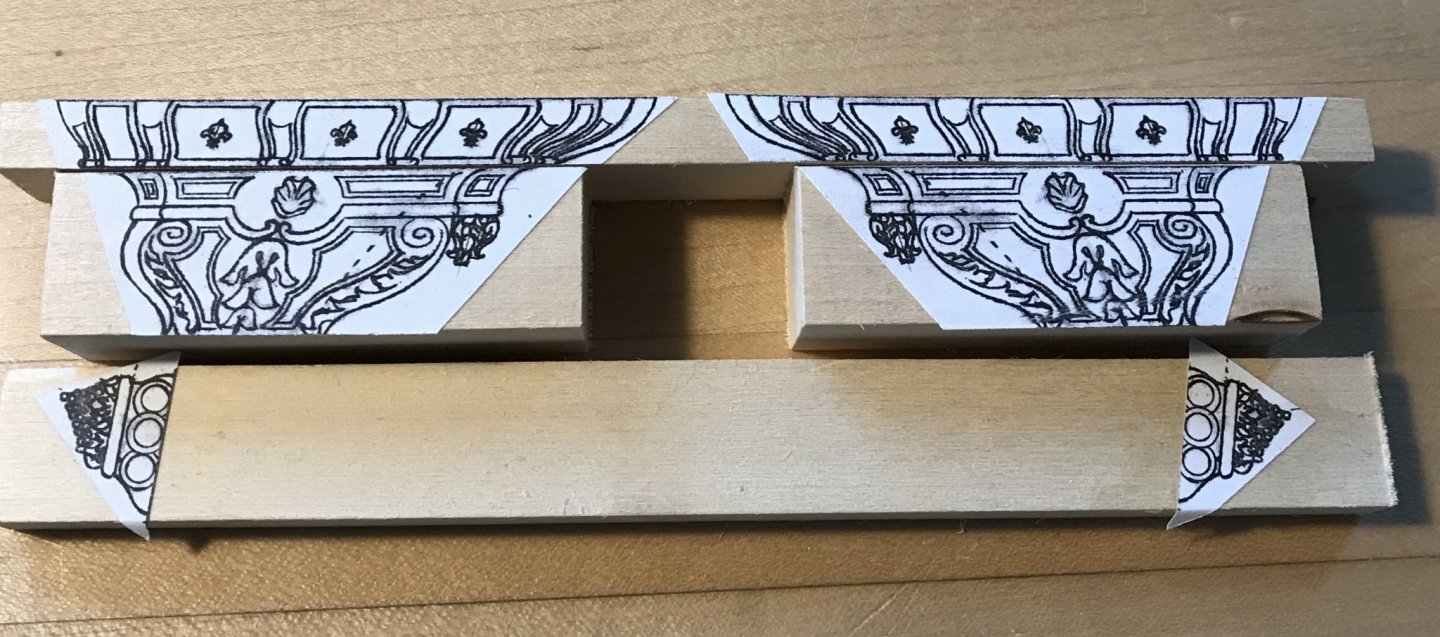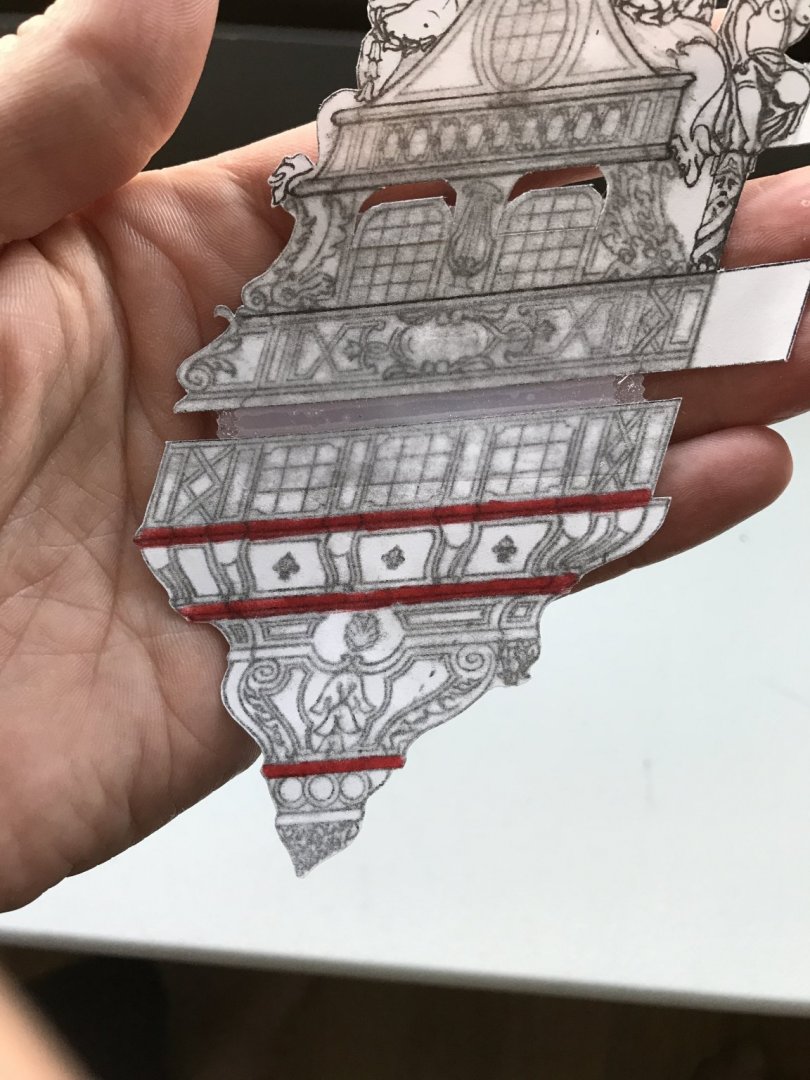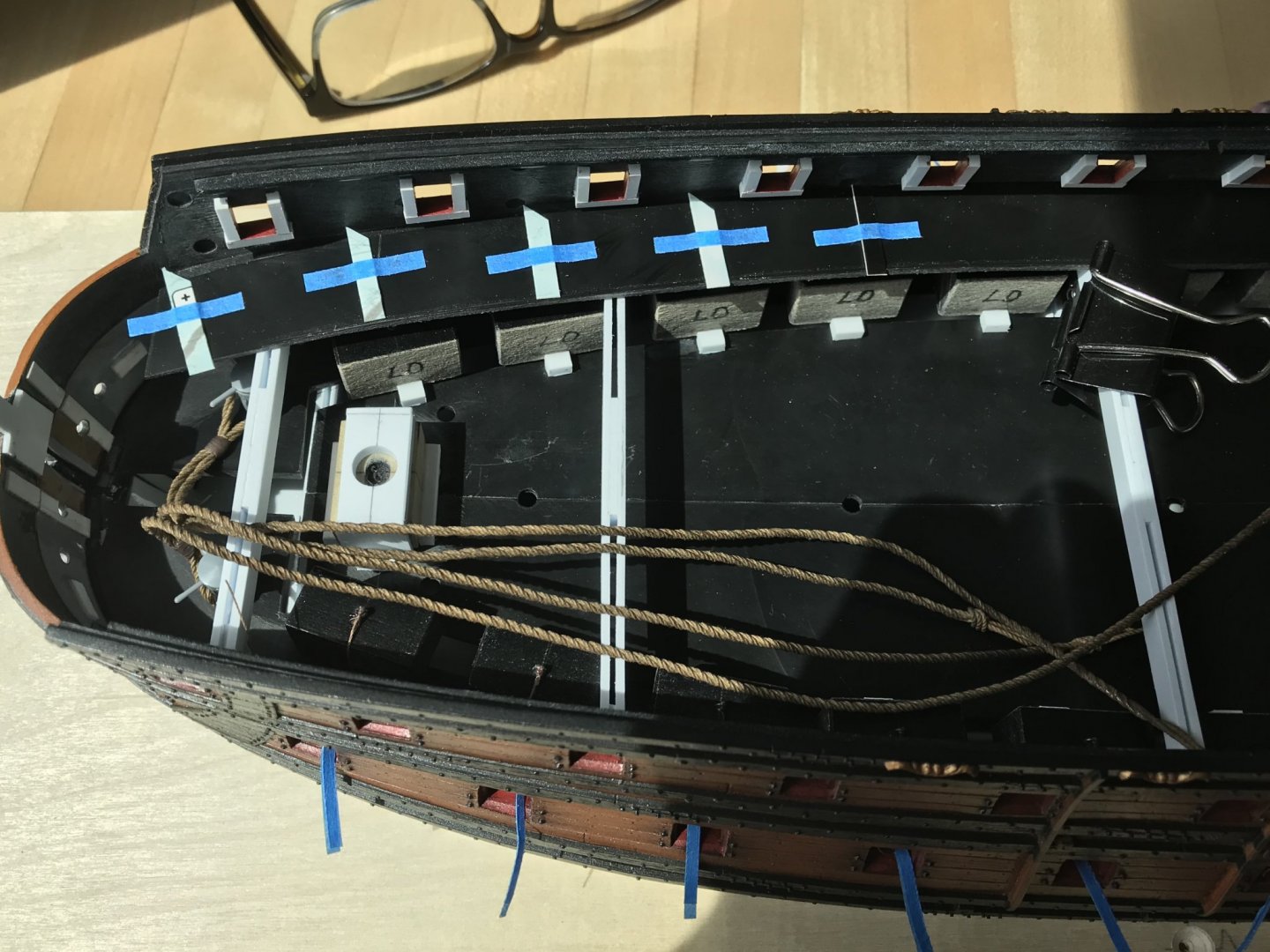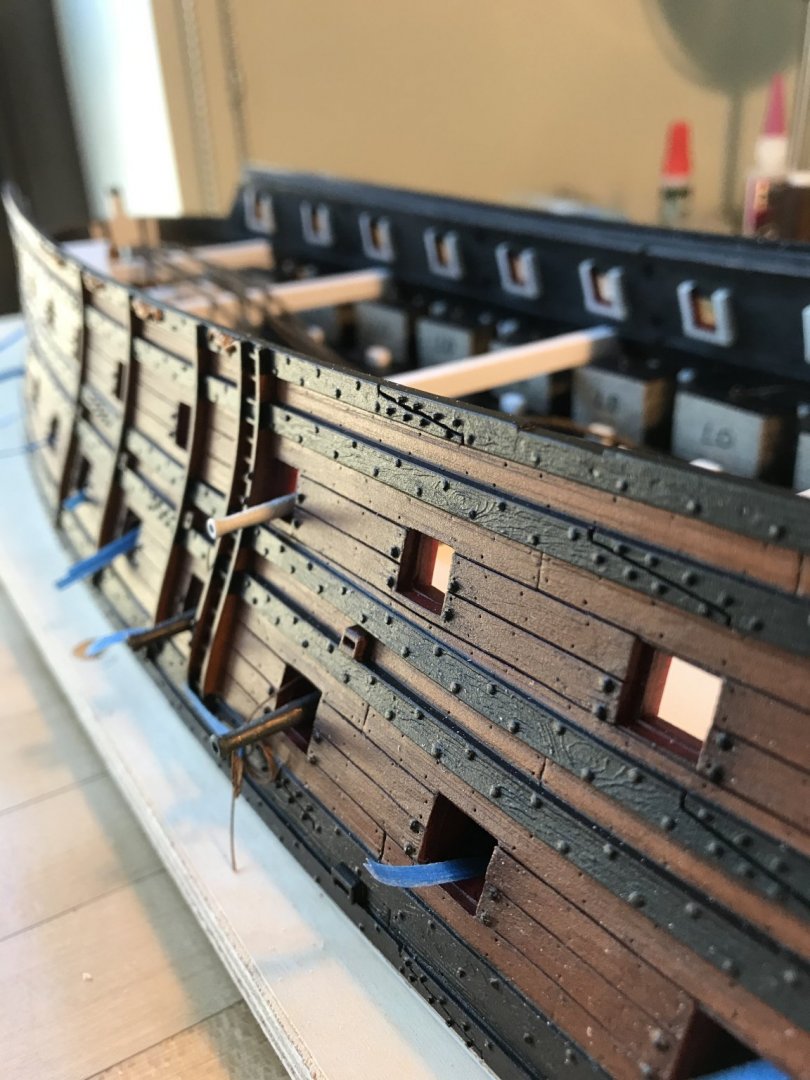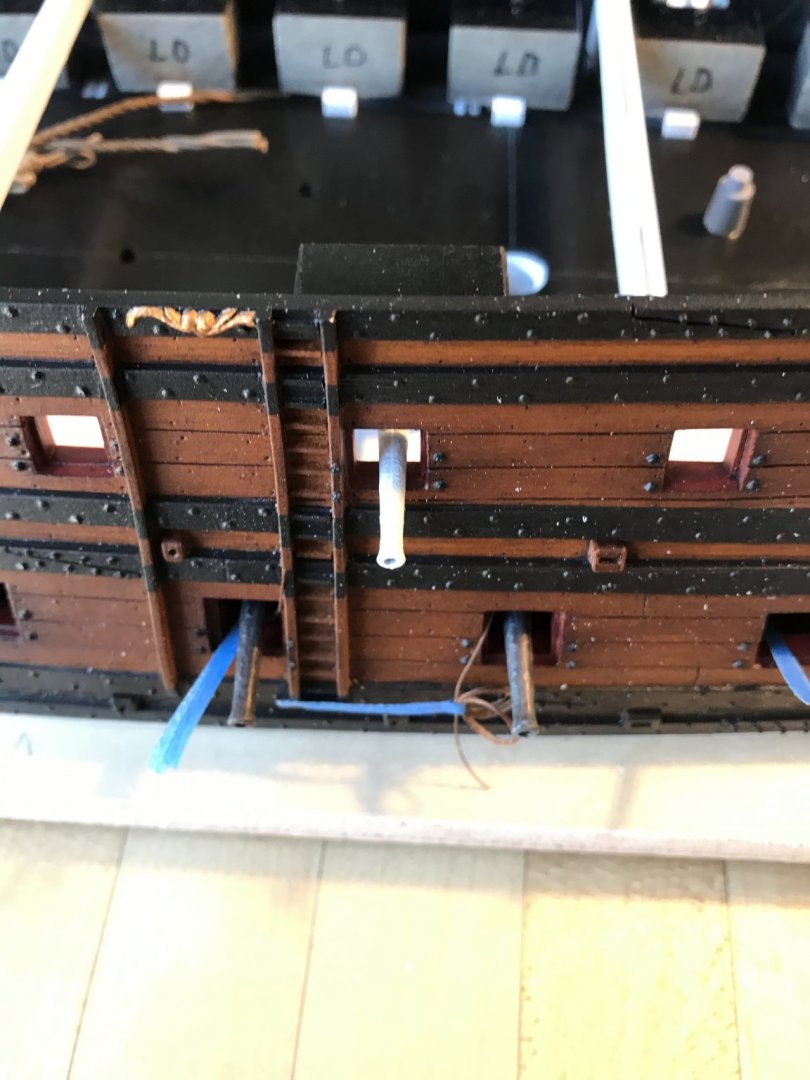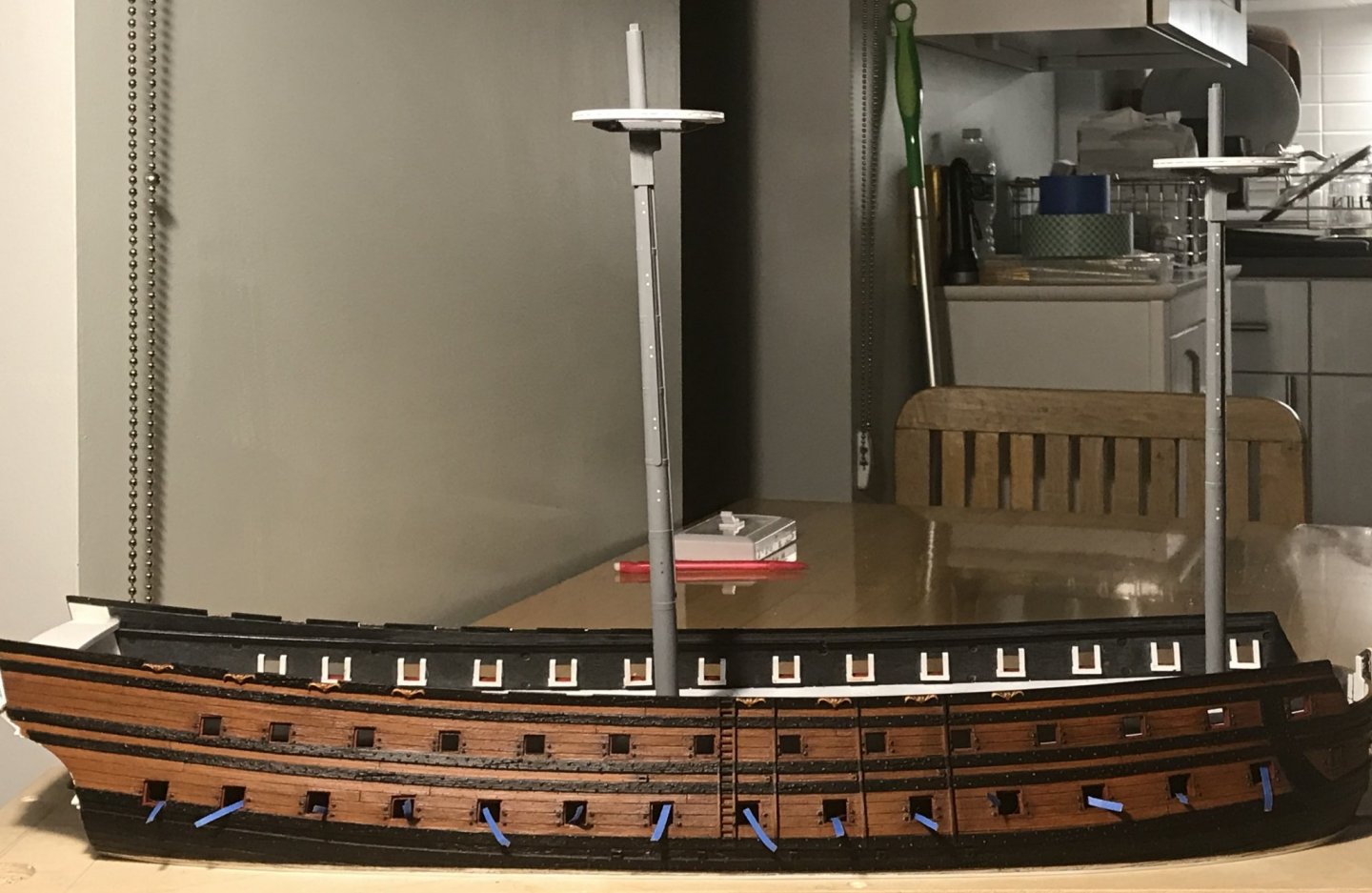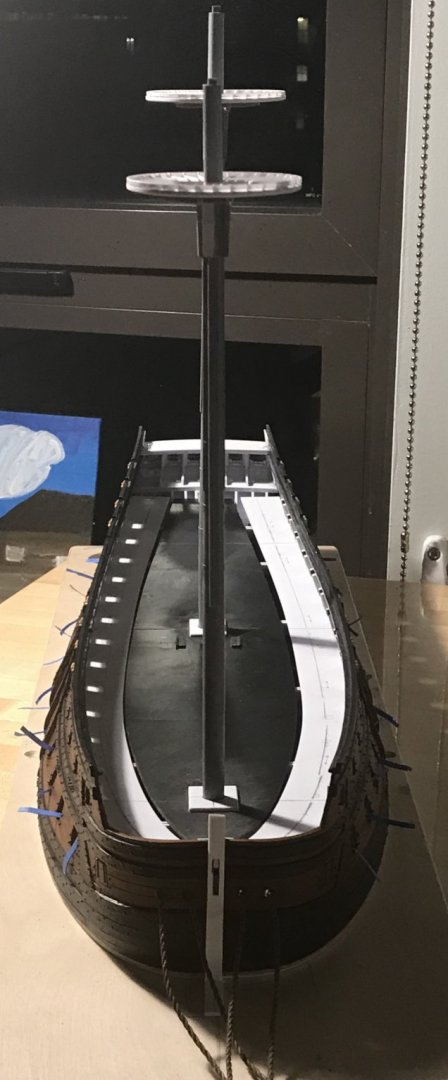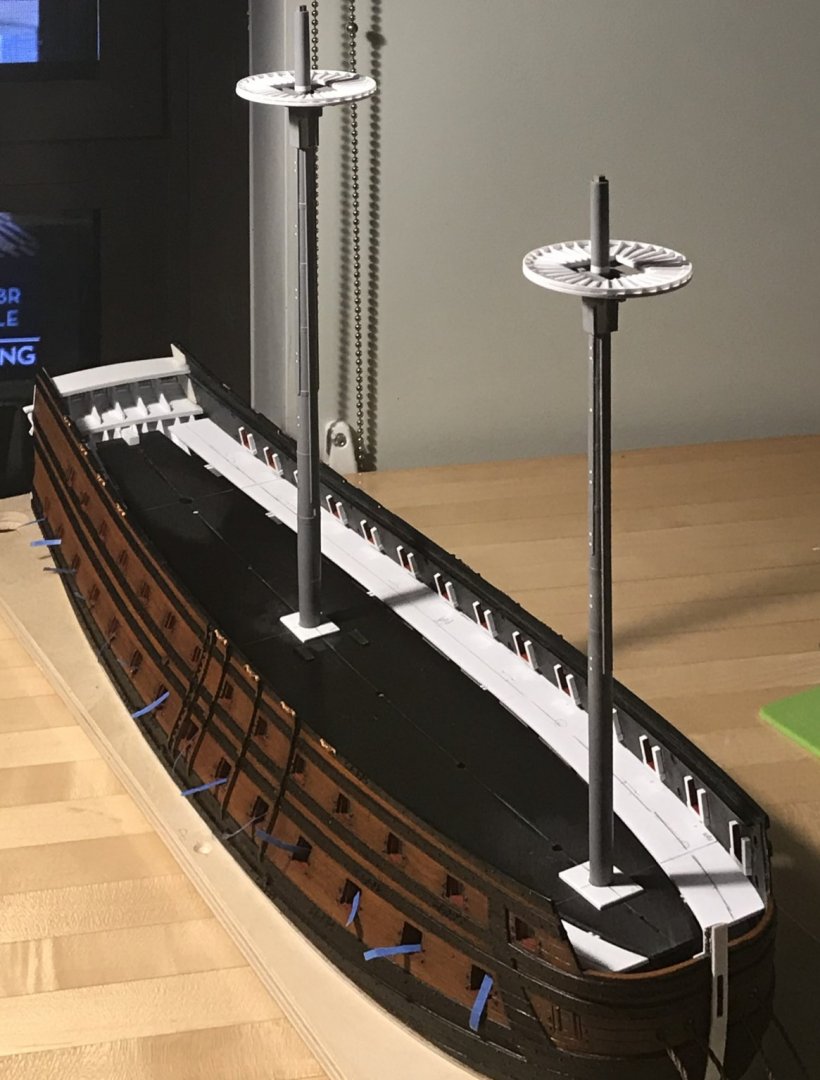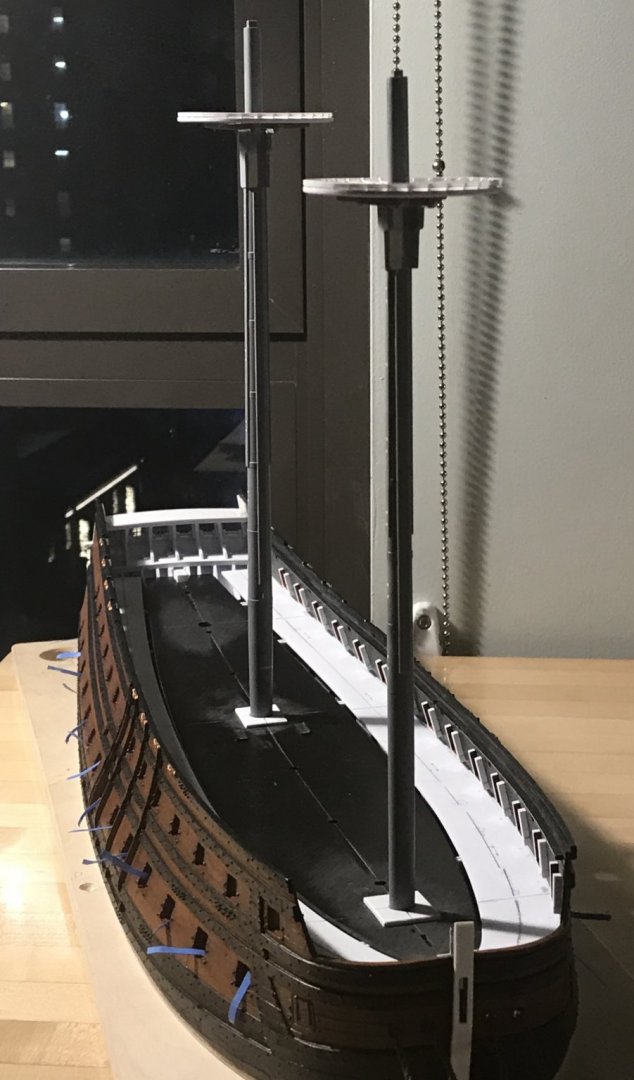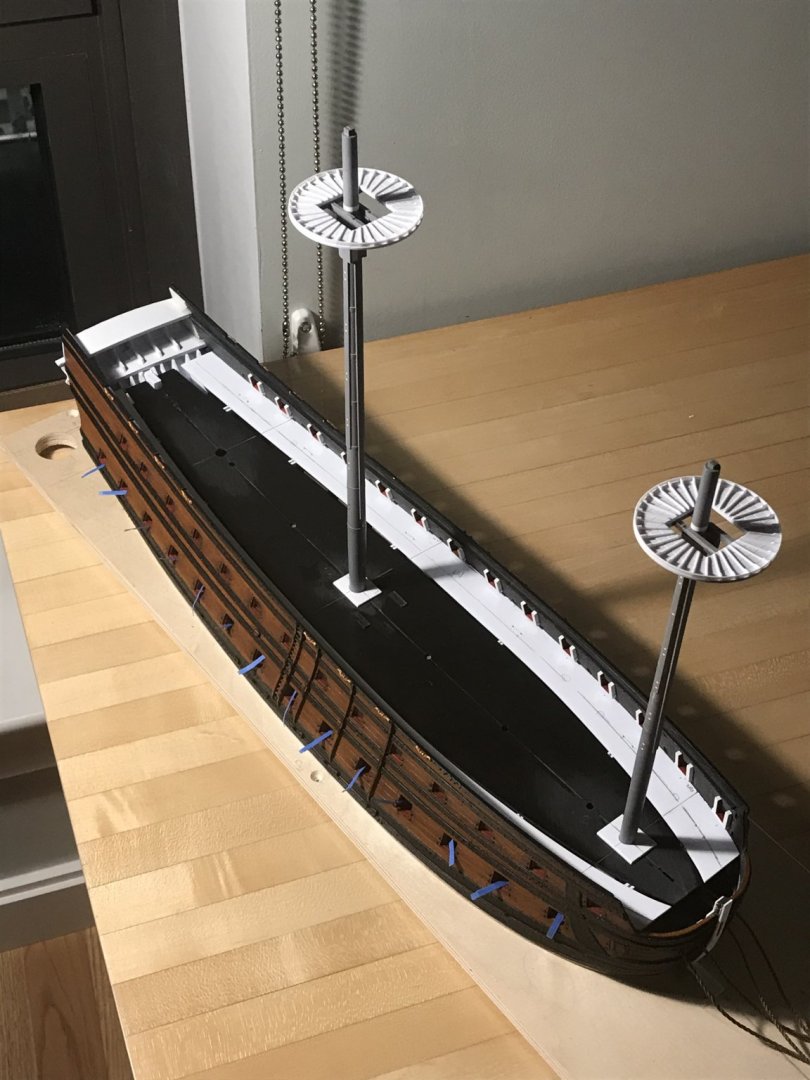I am glad that you like the gratings. Like a number of modifications I have made on this model (everything to do with the guns and port lids, for example), the gratings were time-consuming, but the alteration will pay huge dividends on the finished model.
Well, Bill, I have a number of thoughts on the subject of the Heller kit as it relates to Tanneron’s model.
The Heller kit is a direct take-off of Tanneron’s model, and Heller made some attempt to reconcile the incomplete elements of Tanneron’s model.
The kit creators realized that it would be incongruous with the 17th C.French style to leave the upper bulwarks as devoid of ornamentation.
So, it appears to me, they did two main things: they adapted the Berain/Vary upper bulwark frieze of shells and fleur-de-lis into a simplified form between the drift rails; it is approximate, but the inspiration is clear.
Secondly, they took their cue for the repeating Royal monogram of crossed L’s, between the main deck guns, from the Louis Quinze model, which has its origin at the end of the 17th C., and can be viewed as a representative model for a First Rate of the Second Marine.
While Heller markets their kit as being an original representation of the ship in 1669, the architecture of the head, the quarters and the stern do not really reflect what that reality would be.
As for Tanneron, it seems that nobody can say with any certainty what his precise sources for the model were, however, it seems apparent to me that it is a reconciliation of several primary sources.
Tanneron models the quarter galleries as being open, with a walkable lower stern balcony; these traits are hallmarks of ships of the early First Marine building plan, however, their structural arrangement and representation on Tanneron’s model has more in common with ships built after 1693.
This well known drawing that I exhaustively argue is actually of the Monarque and not the Royal Louis of 1668, is characteristic of the early style and structure of First Marine Sterns:
View attachment 143457
What Heller modeled, vis-a-vis Tanneron, has much more in common with this:
View attachment 143459
This quarter gallery is shown as being fully closed in, which is characteristic of the building directives that were finally enacted from the Second Marine building program, in 1693, and thereafter.
This quarter gallery corresponds directly, in every way, with Berain’s stern drawing, for which it is known that Etienne Hubac re-created this ornamentation for the second Soleil Royal in 1693:
View attachment 143461
It is notable to me that the upper bulwark frieze is much simplified, as compared with the earlier Berain/Vary frieze, which I believe is the re-build ornamentation of 1689.
By the time the Second Marine comes into existence, there was a concrete shift toward reduction of ornamentation, even on a principal ship like Soleil Royal.
So, in summary, I believe that Tanneron was primarily using the Louis Quinze model for structural cues, but he was also attempting to represent the earliest incarnation of Soleil Royal with her taller sheer, her open quarters and her three walkable stern balconies:
View attachment 143458
Nobody I have read or spoken with can definitively say why Tanneron’s representation of Berain’s stern is divergent in so many important ways; chief among these differences is the representation of five stern lights, as opposed to six.
This is curious, but not uncharacteristic for Tanneron who also made similar divergent choices in his stern representations of Le Brillant and L’Agreable - models which originate from signed and dated drawing sets that are absolutely known to correspond with each other. My analysis of all of these differences is exhaustive and can be found on the main build-log of MSW, although I believe I also copied and pasted that same discussion on the first few pages of this SOS log.
Simply stated, Mr. Tanneron appeared to make divergent choices that aren’t easily understood - especially in the absence of any controversy as to what quarter drawing corresponds with Berain’s stern, at any given point in SR’s history.
All models of Soleil Royal are necessarily a reconciliation of the available sources. What I am attempting to do, within the confines of the pre-established Heller kit architecture, is to provide a more representative view of a French First-Rate in 1689, as understood through representations of her better documented contemporaries. I call it a “forensic reconstruction,” but it is really a reconcilliation of construction trends that I’ve been mapping across the progression of the French 17th Century.
My model is an amalgamation of compromises that I would prefer not to make, ideally, and yet it is slowly transforming into something much more interesting than the sum of its parts.
A number of people disagree with what I am doing, and that is, of course, their prerogative. I suspect that some of those people, though, may be somewhat surprised when they can eventually, finally see what I see, as the model rounds into form.
It’s all a process, and we will get there eventually. Thank you for looking in.
I am glad that you like the gratings. Like a number of modifications I have made on this model (everything to do with the guns and port lids, for example), the gratings were time-consuming, but the alteration will pay huge dividends on the finished model.
Well, Bill, I have a number of thoughts on the subject of the Heller kit as it relates to Tanneron’s model.
The Heller kit is a direct take-off of Tanneron’s model, and Heller made some attempt to reconcile the incomplete elements of Tanneron’s model.
The kit creators realized that it would be incongruous with the 17th C.French style to leave the upper bulwarks as devoid of ornamentation.
So, it appears to me, they did two main things: they adapted the Berain/Vary upper bulwark frieze of shells and fleur-de-lis into a simplified form between the drift rails; it is approximate, but the inspiration is clear.
Secondly, they took their cue for the repeating Royal monogram of crossed L’s, between the main deck guns, from the Louis Quinze model, which has its origin at the end of the 17th C., and can be viewed as a representative model for a First Rate of the Second Marine.
While Heller markets their kit as being an original representation of the ship in 1669, the architecture of the head, the quarters and the stern do not really reflect what that reality would be.
As for Tanneron, it seems that nobody can say with any certainty what his precise sources for the model were, however, it seems apparent to me that it is a reconciliation of several primary sources.
Tanneron models the quarter galleries as being open, with a walkable lower stern balcony; these traits are hallmarks of ships of the early First Marine building plan, however, their structural arrangement and representation on Tanneron’s model has more in common with ships built after 1693.
This well known drawing that I exhaustively argue is actually of the Monarque and not the Royal Louis of 1668, is characteristic of the early style and structure of First Marine Sterns:
View attachment 143457
What Heller modeled, vis-a-vis Tanneron, has much more in common with this:
View attachment 143459
This quarter gallery is shown as being fully closed in, which is characteristic of the building directives that were finally enacted from the Second Marine building program, in 1693, and thereafter.
This quarter gallery corresponds directly, in every way, with Berain’s stern drawing, for which it is known that Etienne Hubac re-created this ornamentation for the second Soleil Royal in 1693:
View attachment 143461
It is notable to me that the upper bulwark frieze is much simplified, as compared with the earlier Berain/Vary frieze, which I believe is the re-build ornamentation of 1689.
By the time the Second Marine comes into existence, there was a concrete shift toward reduction of ornamentation, even on a principal ship like Soleil Royal.
So, in summary, I believe that Tanneron was primarily using the Louis Quinze model for structural cues, but he was also attempting to represent the earliest incarnation of Soleil Royal with her taller sheer, her open quarters and her three walkable stern balconies:
View attachment 143458
Nobody I have read or spoken with can definitively say why Tanneron’s representation of Berain’s stern is divergent in so many important ways; chief among these differences is the representation of five stern lights, as opposed to six.
This is curious, but not uncharacteristic for Tanneron who also made similar divergent choices in his stern representations of Le Brillant and L’Agreable - models which originate from signed and dated drawing sets that are absolutely known to correspond with each other. My analysis of all of these differences is exhaustive and can be found on the main build-log of MSW, although I believe I also copied and pasted that same discussion on the first few pages of this SOS log.
Simply stated, Mr. Tanneron appeared to make divergent choices that aren’t easily understood - especially in the absence of any controversy as to what quarter drawing corresponds with Berain’s stern, at any given point in SR’s history.
All models of Soleil Royal are necessarily a reconciliation of the available sources. What I am attempting to do, within the confines of the pre-established Heller kit architecture, is to provide a more representative view of a French First-Rate in 1689, as understood through representations of her better documented contemporaries. I call it a “forensic reconstruction,” but it is really a reconcilliation of construction trends that I’ve been mapping across the progression of the French 17th Century.
My model is an amalgamation of compromises that I would prefer not to make, ideally, and yet it is slowly transforming into something much more interesting than the sum of its parts.
A number of people disagree with what I am doing, and that is, of course, their prerogative. I suspect that some of those people, though, may be somewhat surprised when they can eventually, finally see what I see, as the model rounds into form.
It’s all a process, and we will get there eventually. Thank you for looking in.
Marc,
I will grant that your expertise on French warships of the era is far greater than mine, and that your research is most impressive. However, I have long believed that Tanneron's model is likely based on any sources he may have had concerning LSR of 1693. I know that Etienne Hubac wanted to reflect elements of his father's design into the ship of his own design, but I have no primary sources to back this up. I will be studying this history as much as I possibly can without speaking or reading French.





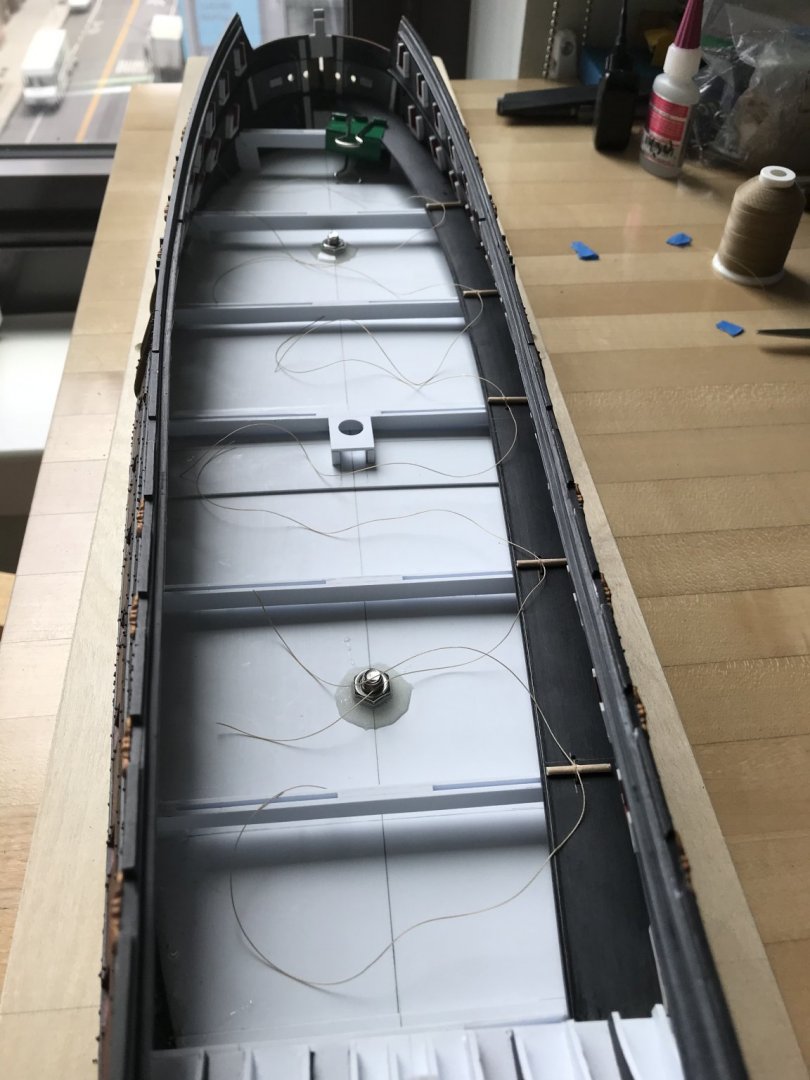
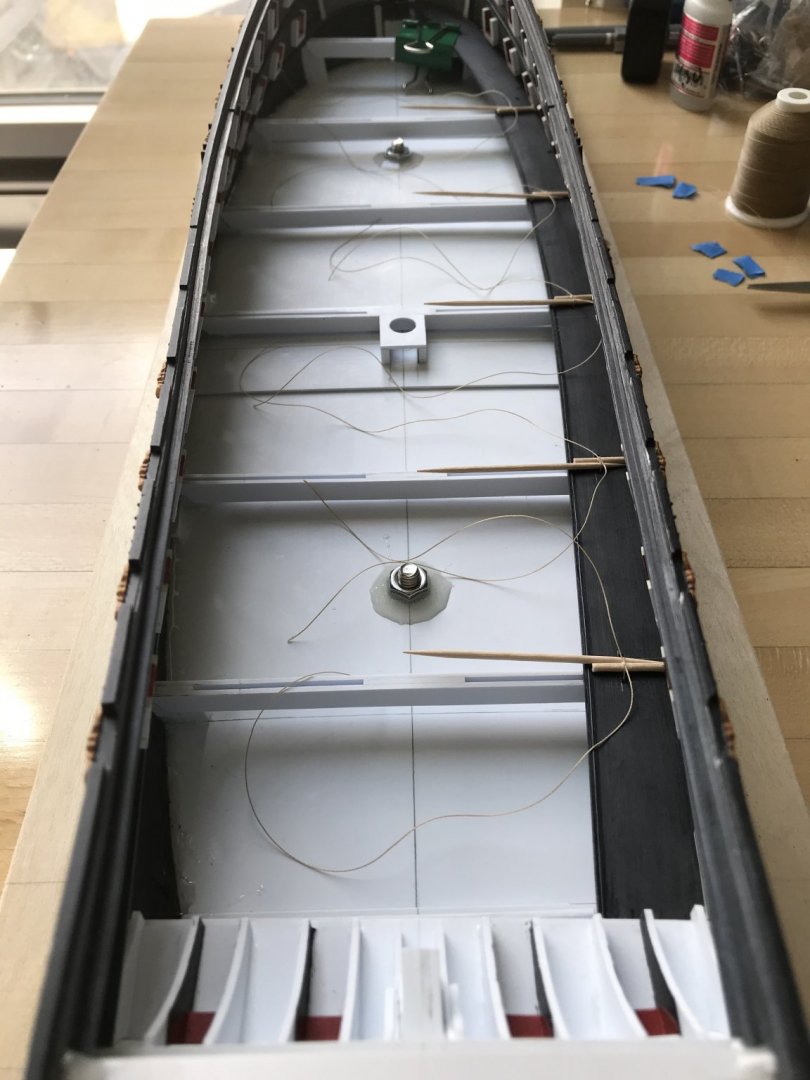
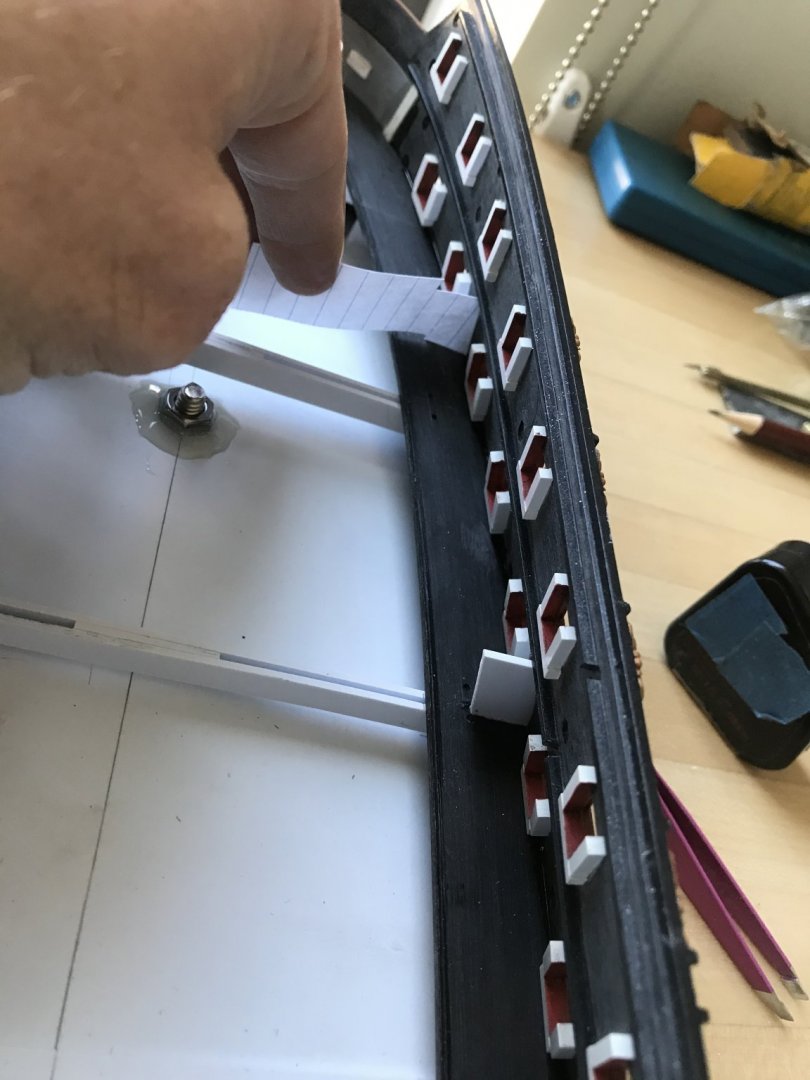
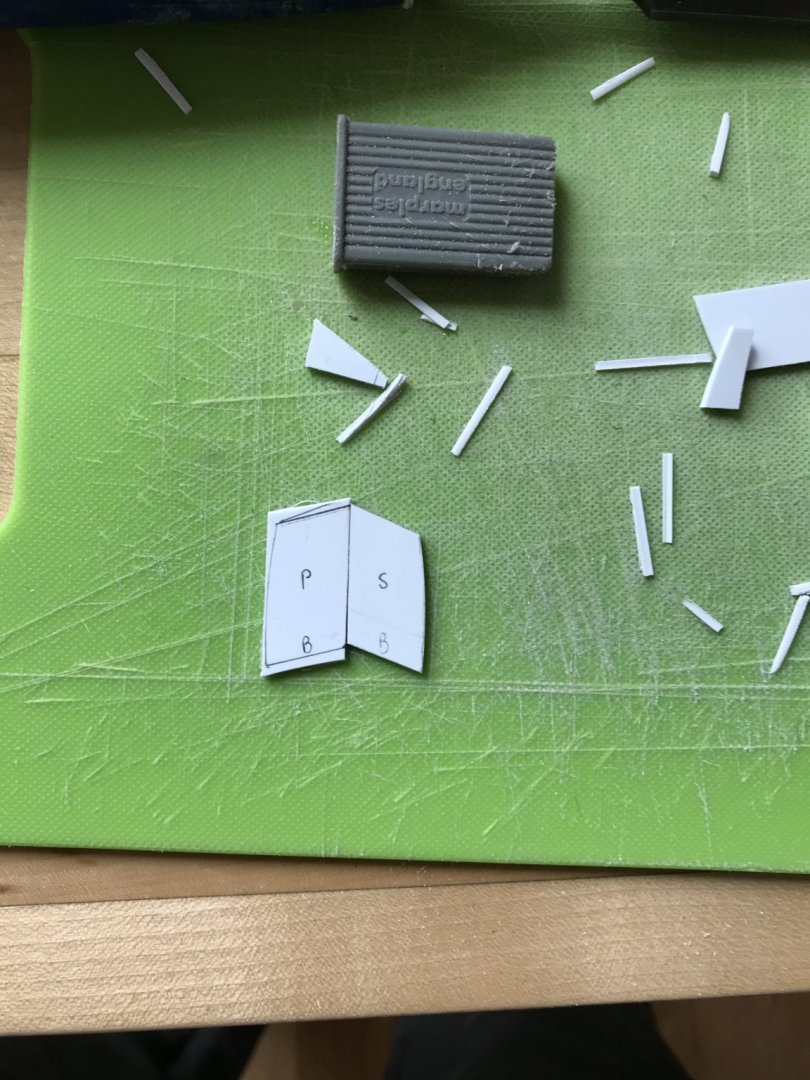
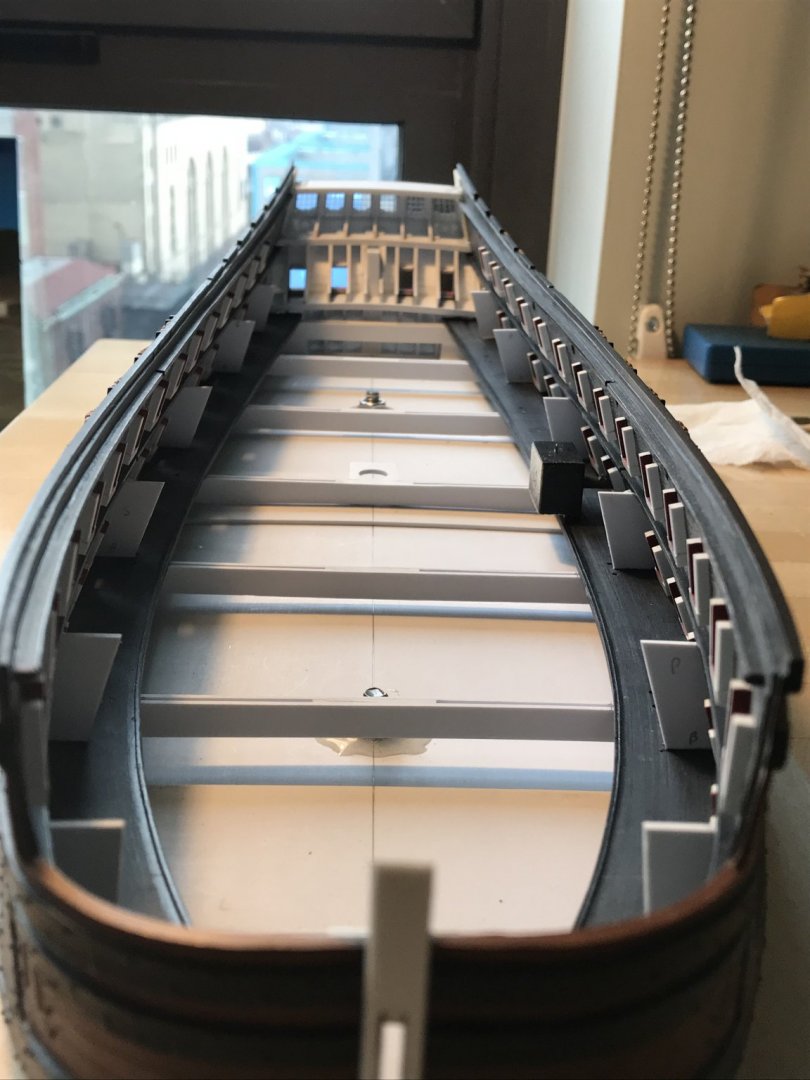
 , no problem; I simply shimmed each dummy carriage with a length of 1/16” styrene. In the following picture, you can see these shims (on the left row), which I’ve blacked out with permanent marker, as well as the annealed wire eyelets I made for the port lid laniards:
, no problem; I simply shimmed each dummy carriage with a length of 1/16” styrene. In the following picture, you can see these shims (on the left row), which I’ve blacked out with permanent marker, as well as the annealed wire eyelets I made for the port lid laniards: